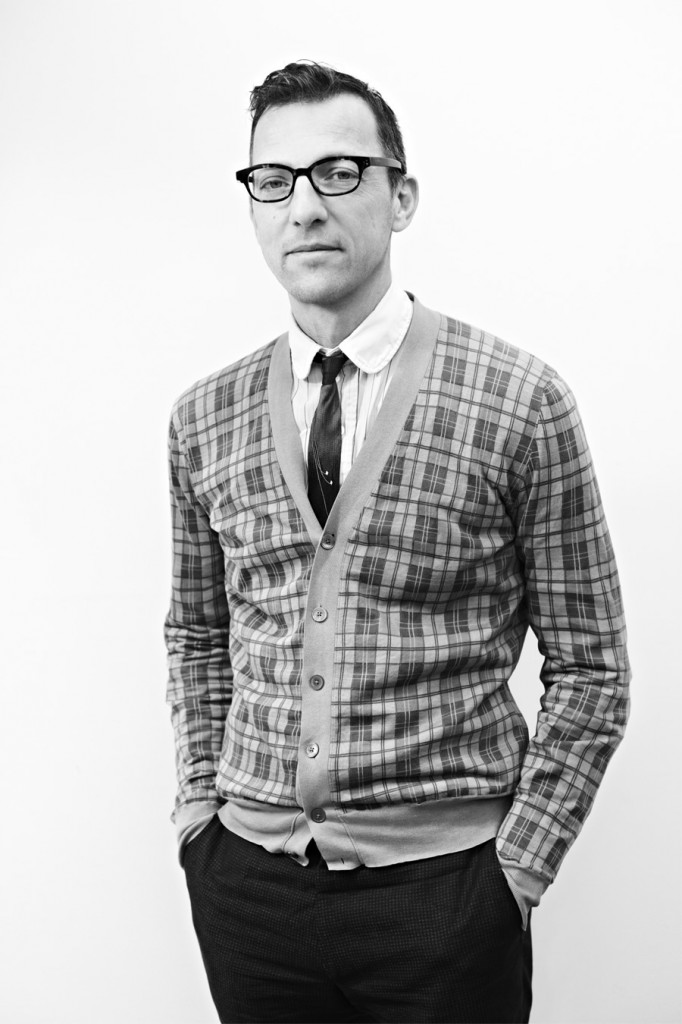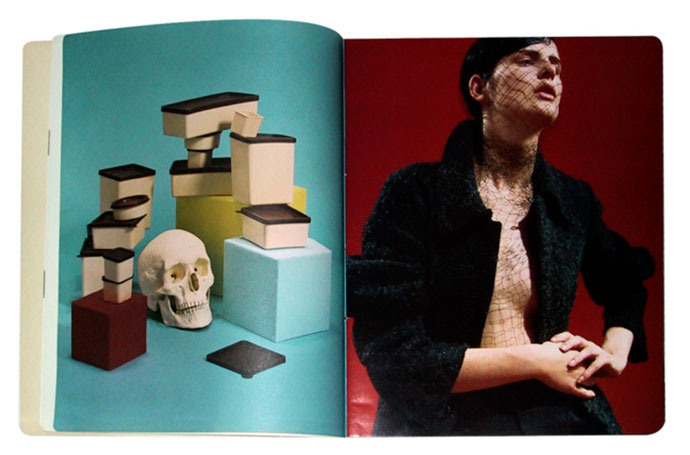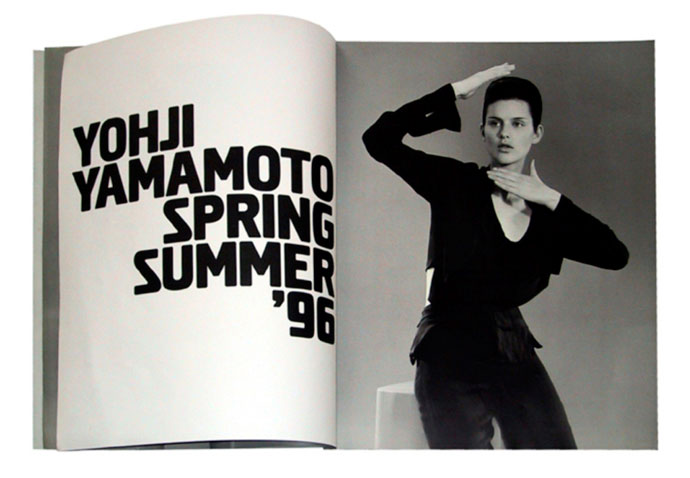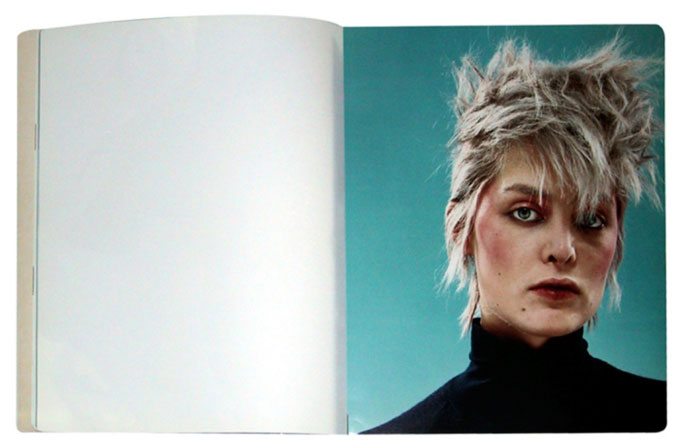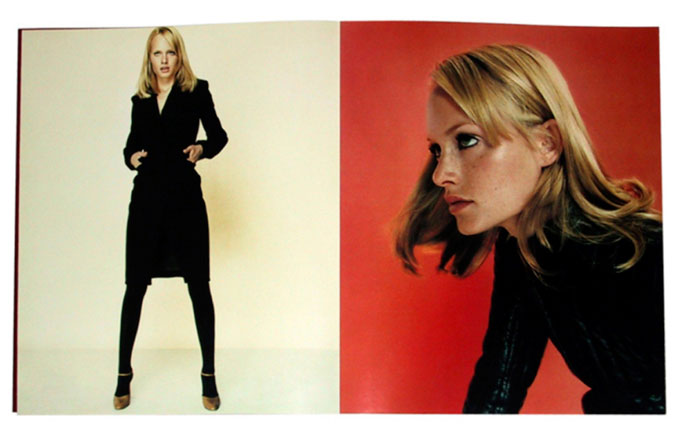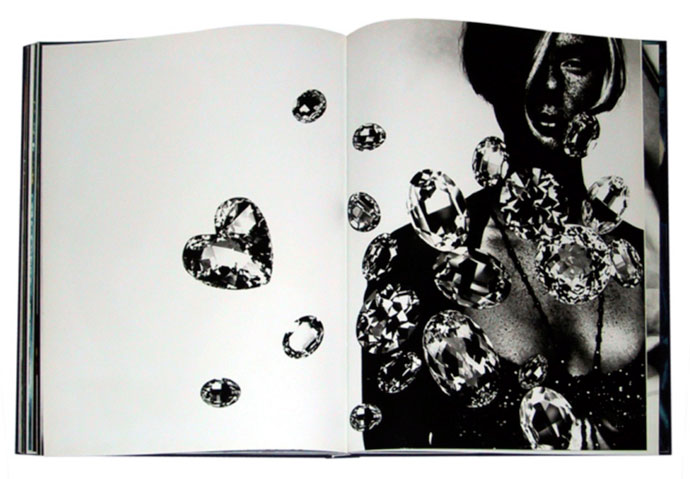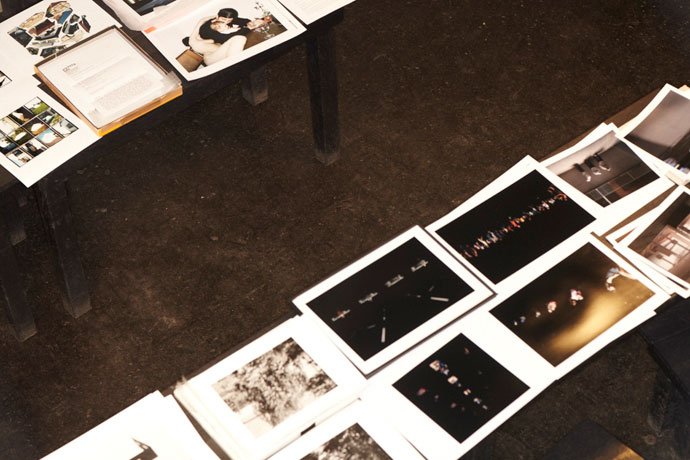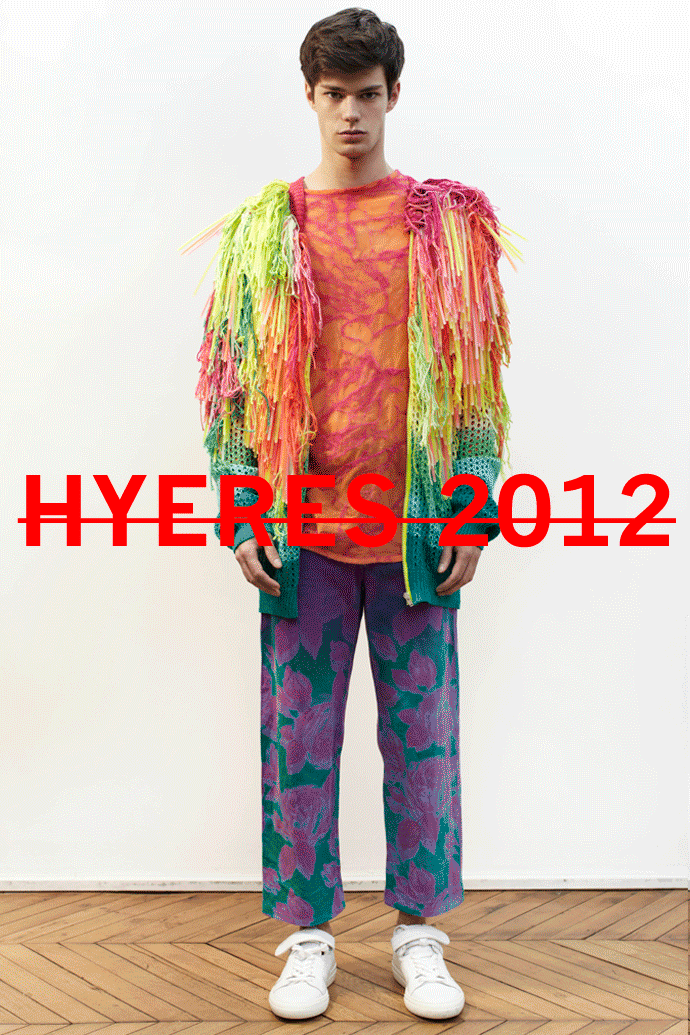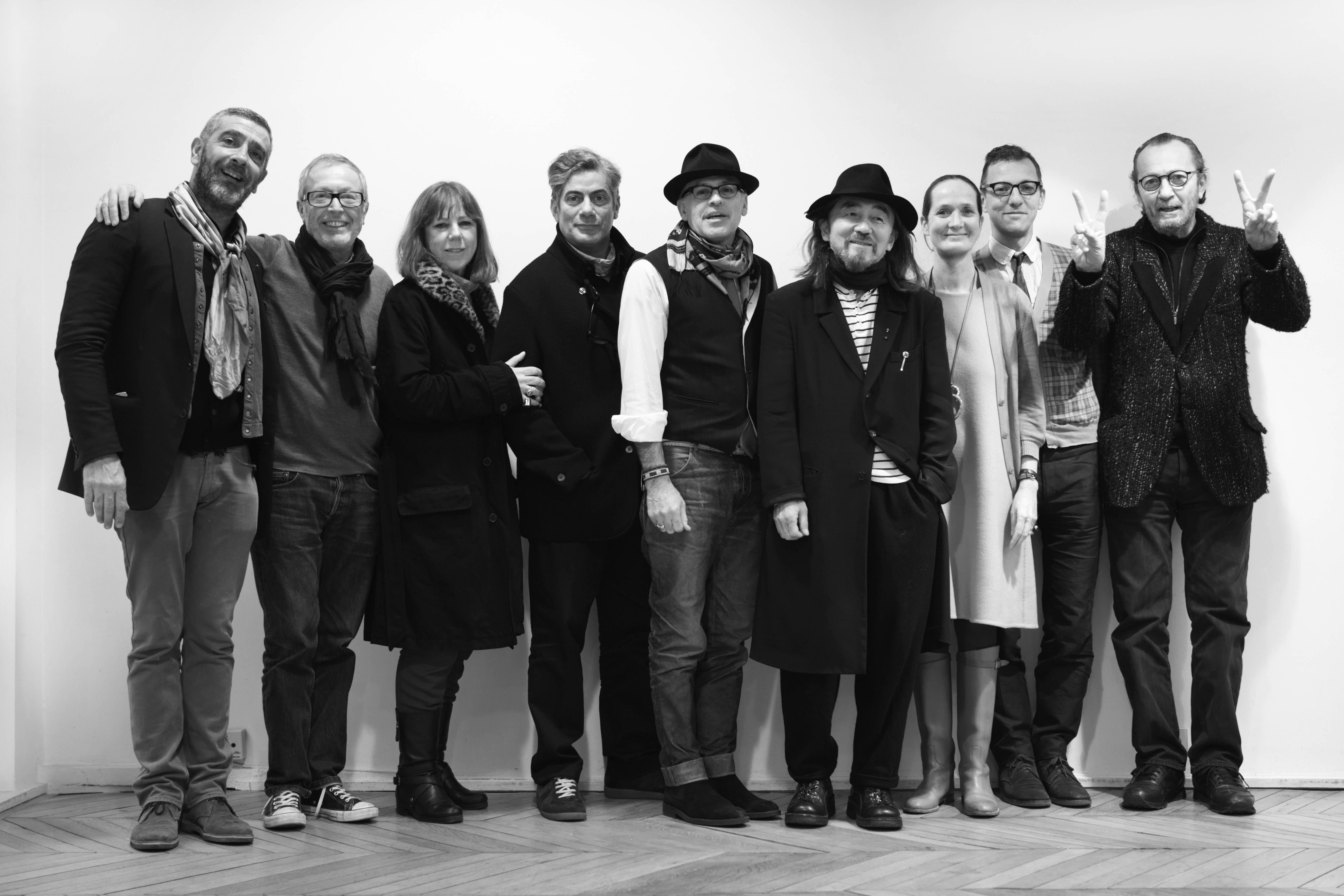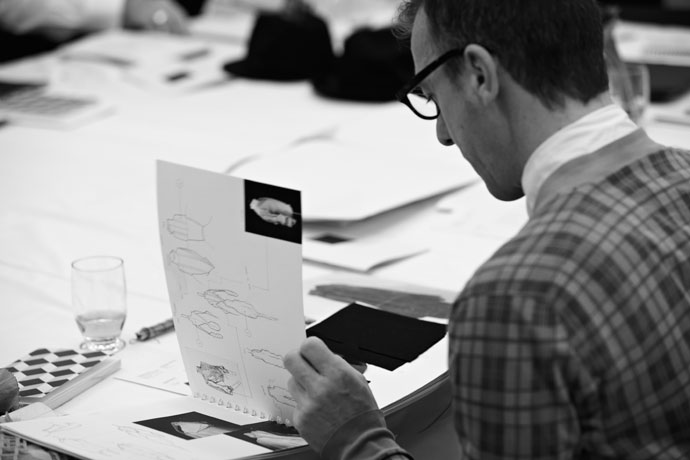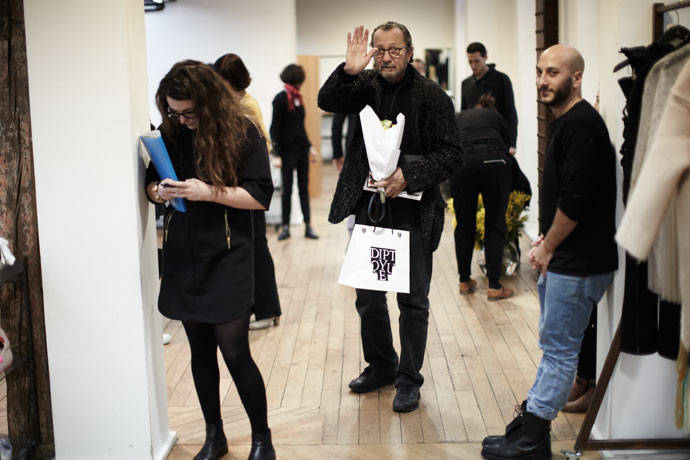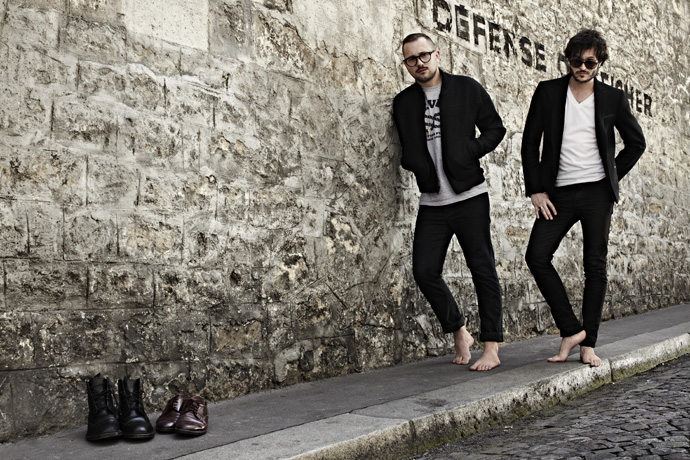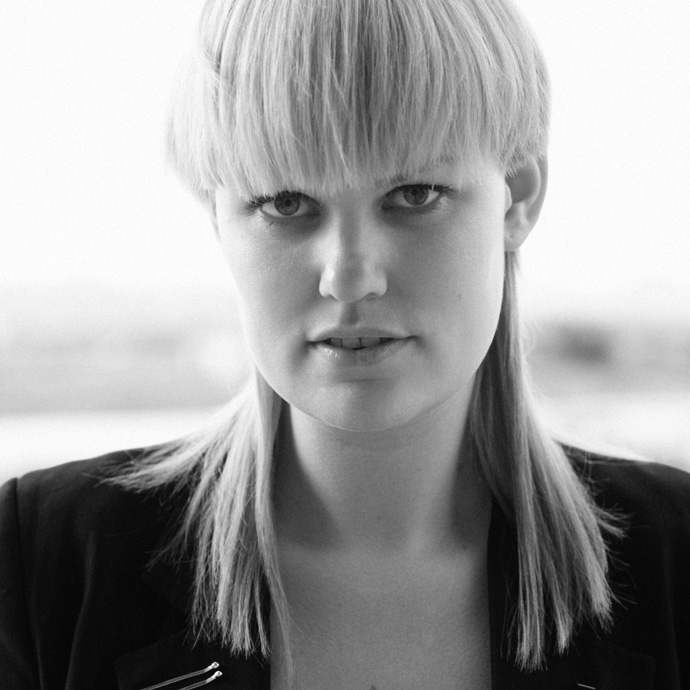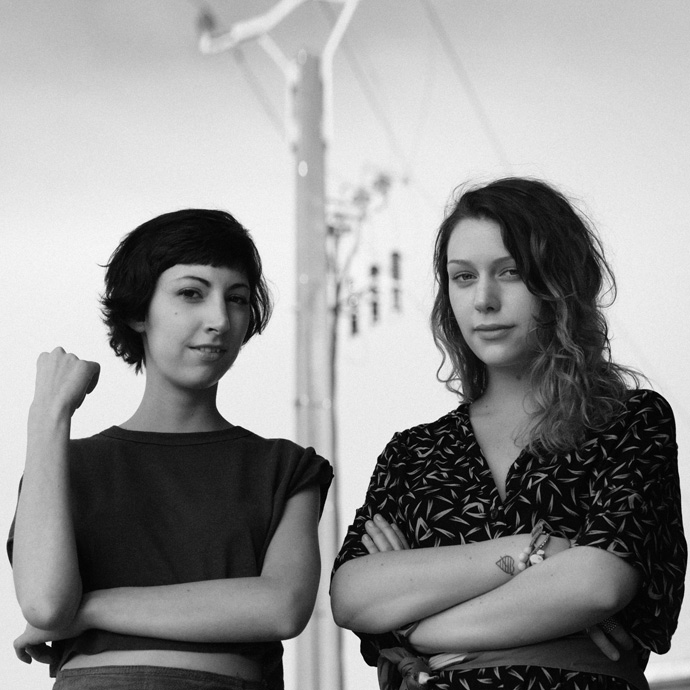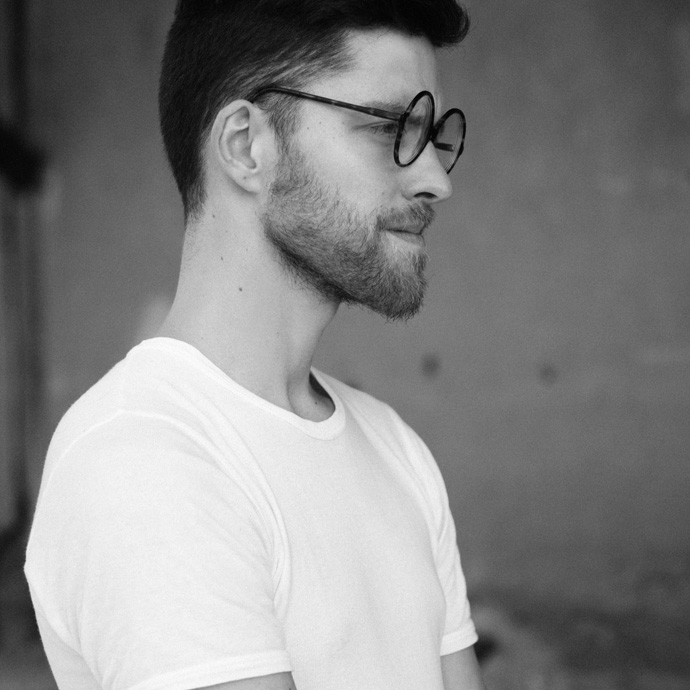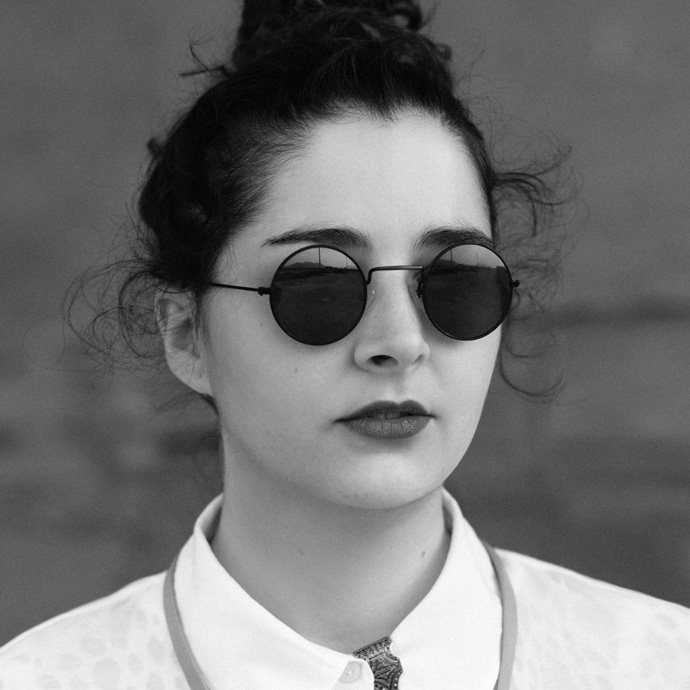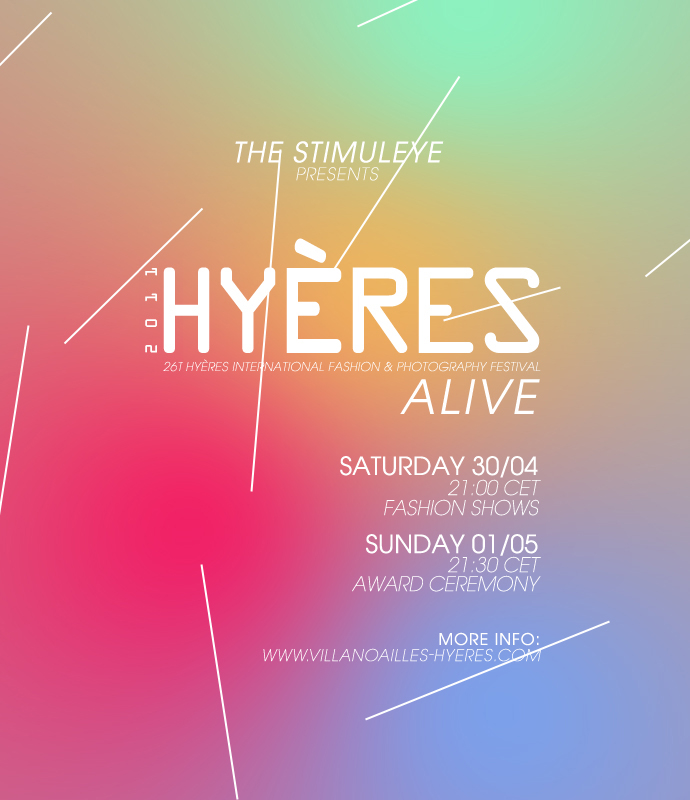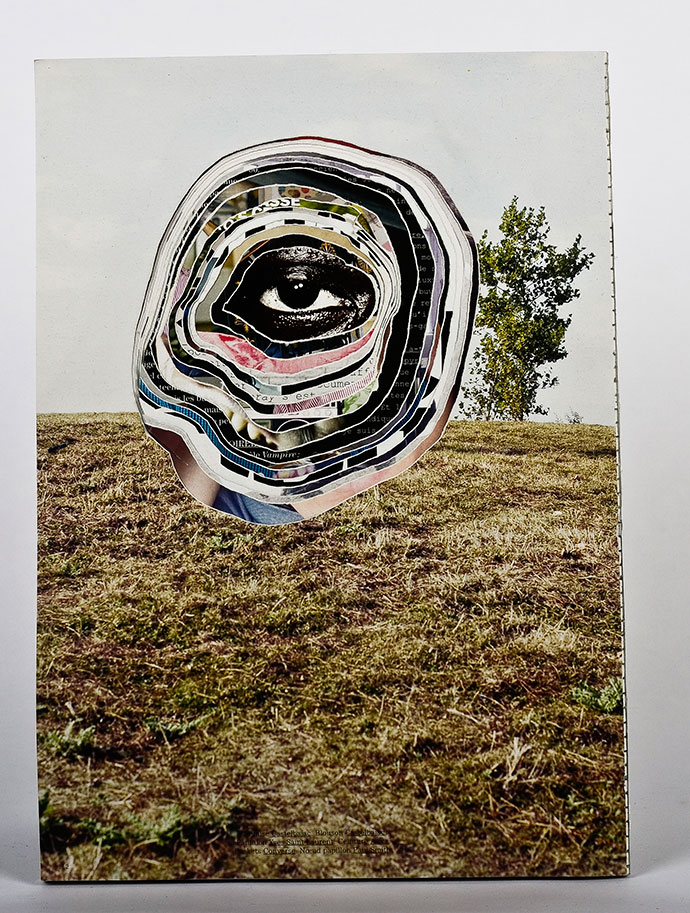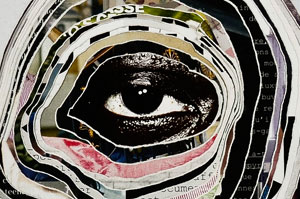-

hyères juste a taste…Alan Bilzerian
-Among the crew of fashion wisemen assembled by Yohji Yamamoto in the Hyères 2012 jury is Alan Bilzerian, owner of the eponym Boston boutique, who was kind enough to answer the questions of the Hyères partner blogs…
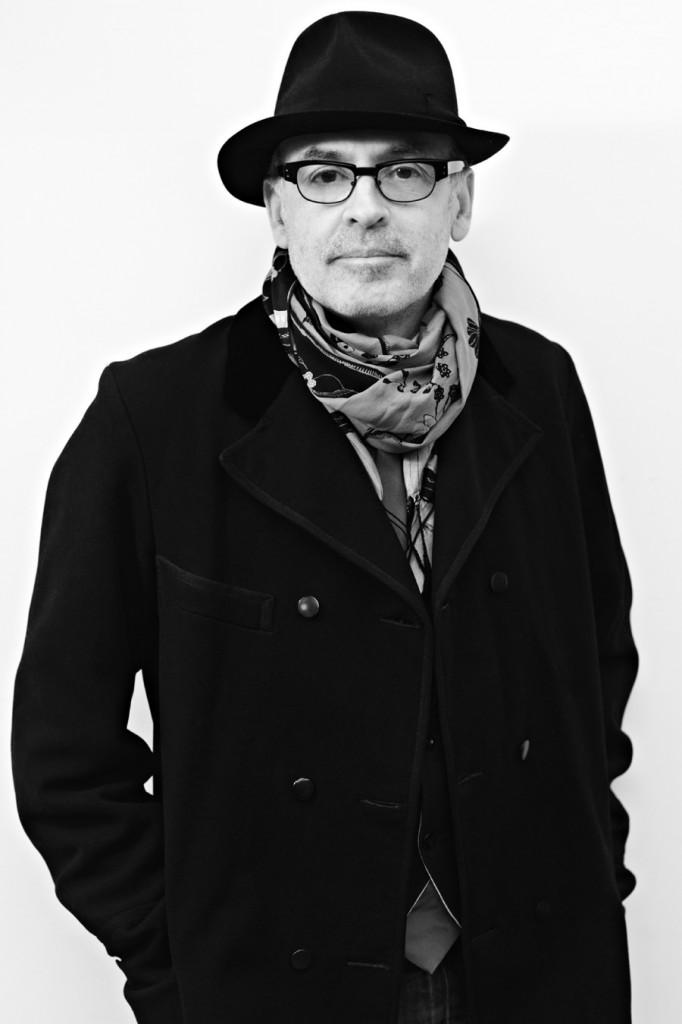 Alan Bilzerian by René Habermacher.
Alan Bilzerian by René Habermacher.How important is craftsmanship in a collection for you?
Actually, its one of the first points that bring me closer to the designer. It puts a skip in my step when young designers succeed in translating quality.
When looking at the Hyères ranges, what is more important to you, the designer’s ability to conceptualize a range and see it through to its most artistic and expressive, or do you focus strongly on the commercial viability of the ranges?
I feel very uncomfortable about looking at large ranges of any designer. I believe you can exhibit your emotion of design very clearly in short exhibitions. But I look at both the commercial side as well as artistic expression.
How supportive are your consumers to young designers? What is the most challenging aspect of trying to sell a young designer, and what can the designers do about it?
The consumer will listen to us about any new designer and will certainly give it a chance with a try on or touch. The competition is so strong because of the immense amount of product, we feel you need a little push from the editorial side and a strong support system with shops of high caliber.
The corporate fashion conglomerates are assembling more and more brands under their umbrella and control through advertising the exposure of fashion in the editorials.This makes it harder for young, independent designers to create visibility and establish their vision and brands. How do you see this affecting your work as a buyer?
Its always very challenging to move into new names because in my shops I like consistency to prove that I made the right decision for the customer. The fashion umbrella of the conglomerates are needed as well because of the visible progress shown to the consumer, it helps momentum.
What is the last thing that you experienced, saw or heard that stimulated you?
Nostalgia…
00 -

Everything You Need To Know About Hyères 2012 Fashion + Photo Festival
-Everything you need to know about the
Hyères International Fashion + Photography Festival 2012.
April 27-30 2012, Villa Noailles, Hyères, FRANCE.Fashion + photo juries, fashion shows, exhibitions by Yohji Yamamoto, Inez Van Lamsweerde & Vinoodh Matadin, Jason Evans, Chronique Curiosités, Maison Rondini, Matthew Cunnington & John Sanderson, Fabrics Interseason, Lynsey Peisinger & The Stimuleye, Lea Peckre, Celine Meteil, Internationales Fashion + Textile Conferences, The Shoes/TEED/Citizens…
a film by The Stimuleye,
with Lynsey Peisinger and François Sagat. -

hyères just a taste… Olivier Saillard
-His name may not ring any bells, especially if you’ve never attended one of the numerous exhibitions he curated during his years at Union des Arts Décoratifs or more recently in his new position as curator for Paris’ Galliera Fashion Museum.But his appreciation, his judgement, informed by an impressive culture and understanding of fashion in the long run, leave little to doubt.Who better to evaluate the young talent of tomorrow than one of the few people who get fashion beyond the trends of the moment ?Days before his double Comme des Garçons / Balenciaga exhibit opens at Cité de la Mode, here is Olivier Saillard.Hyères 2012 jury member, Olivier Saillard, Director of the Galliera Fashion Museum. Photo by René Habermacher.
Why should a garment be considered as important?At the risk of appearing a bit primal, because we’d be a bit cold if we had to live naked, unless we all moved to warmer pastures !
Beyond climatic considerations, I love to see a garment as a solution, and to note that some designers are, to this day, still preoccupied by the idea of solving, through a way of dressing, our natural morning wardrobe.You have produced works that straddle the line between fashion and performance. Or maybe there is no line. When looking at the collections for the festival, how important is the element of presentation to you? Would a poor presentation of a great garment influence how you score it?Now more than ever, presentation interests me less than the garment itself. I skip fashion shows and rather appreciate presentations in show rooms.
(more…) -

hyères just a taste…. Marc Ascoli
-“Fashion goes out of fashion” says veteran creative director Marc Ascoli.
A jury member for the upcoming Hyères Fashion + Photography Festival, Ascoli is known as the man behind the image of Yohji Yamamoto, Martine Sitbon, Jil Sander for many years.
He knows the times change, and yet the thirst for creativity is never quenched.
Here’s a taste of Hyères.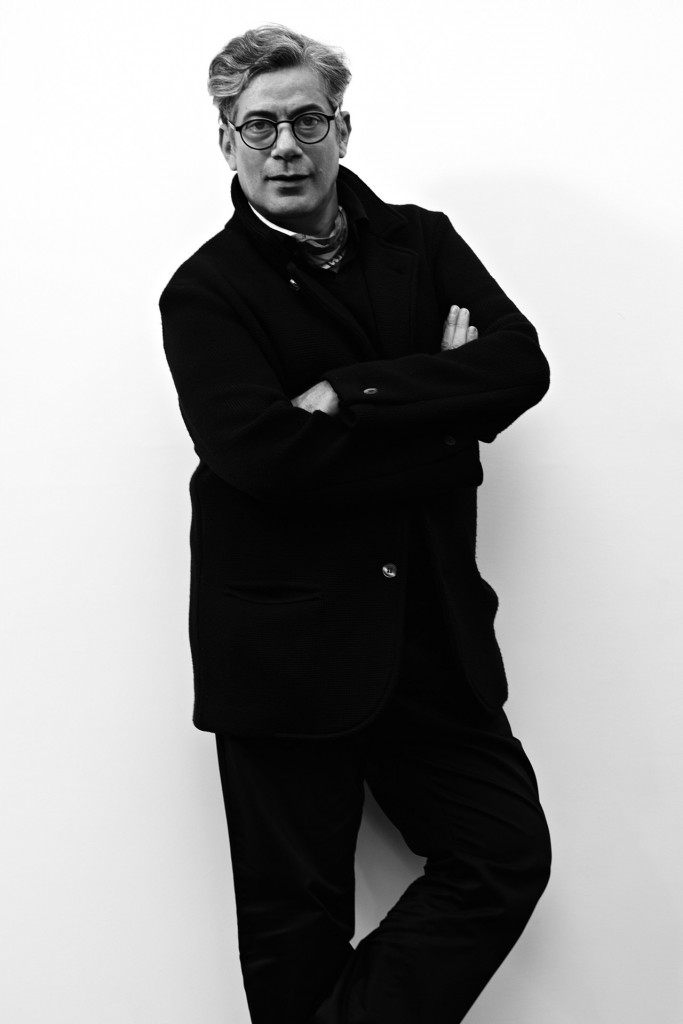 Marc Ascoli at the Hyères 2012 jury selection, by René Habermacher.
Marc Ascoli at the Hyères 2012 jury selection, by René Habermacher.FILEP MOTWARY/UN NOUVEAU IDEAL: What makes a young designer interesting in your eyes ?
His/her sensibility before anything else, that he/she has something to say. But also the degree of creativity, the ability to show he/she doesn’t fit the mold or follow established models.
A young designer, to be interesting, needs to reflect his era and talk about the times.
MALI/SKATTIE: Once you’ve started working with a brand, what is your degree of involvement and counseling?
It really depends on the intensity of the relationship I share with the person. Today the difficulty is to know which direction a brand wants to go, how to express its singularity.
Marc Ascoli + photographer David Sims for Yohji Yamamoto.
MISHA/TOKYO FASHION DIARIES: Today, it seems essential for a designer to have a public persona. How does that affect you ?
The current situation is ambiguous. Designers are personae, they embody and diffuse the image of the brand. Taking into account the investments made by fashion houses in terms of publicity, designers have become true flag bearers.
But that’s where the error often lies, to hire people gifted in public relations but much less in terms of style.
Today there is a “bottom line” in fashion, people tend to look at things commercially. Does the buzz which personality give off equal the quality of the offering ? The question today is primordial. [In the case of] Sarah Burton for Mc Queen, we don’t see a flamboyant personality, but everyone is floored by her work.
Even though it’s a time of crisis, everything is about competitivity. Considering the number of collections (men’s, women’s, pre-collections), it’s about standing out through quality not only personality.
RENÉ / THE STIMULEYE: What is the role of the stylist in the creation of a fashion image ? How did the evolution of this role impact the role of the artistic/creative director ?
There’s now a lot of confusion between stylists and artistic directors, but I believe the two have very different roles. The artistic director works on the long term image of the brand, its DNA and visual impact, whereas the stylist reflects the brand’s fluctuating image by styling the clothes, whether it’s for ad campaigns or a fashion shows.
Marc Ascoli + photographer Craig McDean for Jil Sander
BRUNO / BRRUN: Does fashion have a political role beyond aesthetic and function ?
Fashion takes place in a different universe. It’s a universe where you’re bringing something else to reality, where there is little concern for politics, because it’s all about creation and individuals.
You can see today that there is a huge gap between fashion and the political reality of our times.
Fashion goes out of fashion; fashion is irrational so it can’t be political.ANTOINE / THE STIMULEYE: When and how does a creator, singer, artist need to work with an art or creative director ?
An artist always needs an alter ego with whom to exchange ideas, to help write his/her story. It’s not just a matter of positioning. The artistic director has to be sensitive enough to understand the artist’s universe and then catalyze it ; establish an image visually and eventually commercially.
Marc Ascoli + photographer Nick Knight for Martine Sitbon.
What is the last thing which stimulated you ?
Being a very curious person, I am constantly stimulating my creativity through various cultural activities. The exhibit of Madame Grès curated by Olivier Saillard at Musée Bourdelle really seduced me. Everything was in its place, the location, the clothes, the spirit.
I was also very stimulated by the latest Comme des Garçons fashion show. I thought it was majestic.
-

contest: beyond the wall
-For the 27th edition of the Hyères Fashion + Photo Festival, The Stimuleye presents choreographer Lynsey Peisinger’s PILLORY, a performance/video/installation hybrid.
Submit your 30 seconds maximum video before April 1st for a chance to have it featured in the installation, which launches April 27th at the 2012 Hyères Fashion + Photo Festival, next exhibits by Yohji Yamamoto, Jasons Evans, and Inez van Laamswerde + Vinoodh Matadin.
Imagine what lies beyond the wall of the PILLORY installation.
All submitted videos must be
no more than 30 seconds long,
from one angle/point of view,
and submitted before April 1st, 2012.Fore more info and video guidelines: contest@thestimuleye.com
-

HYERES 2012, the photo selection
-How do you reduce 782 applications into a curated selection of 10 photographers ?
Where is photography going today ?
Can the promise of future creation outweigh present output ?I wouldn’t want to have to answer those questions, but the Hyères photo jury had to.
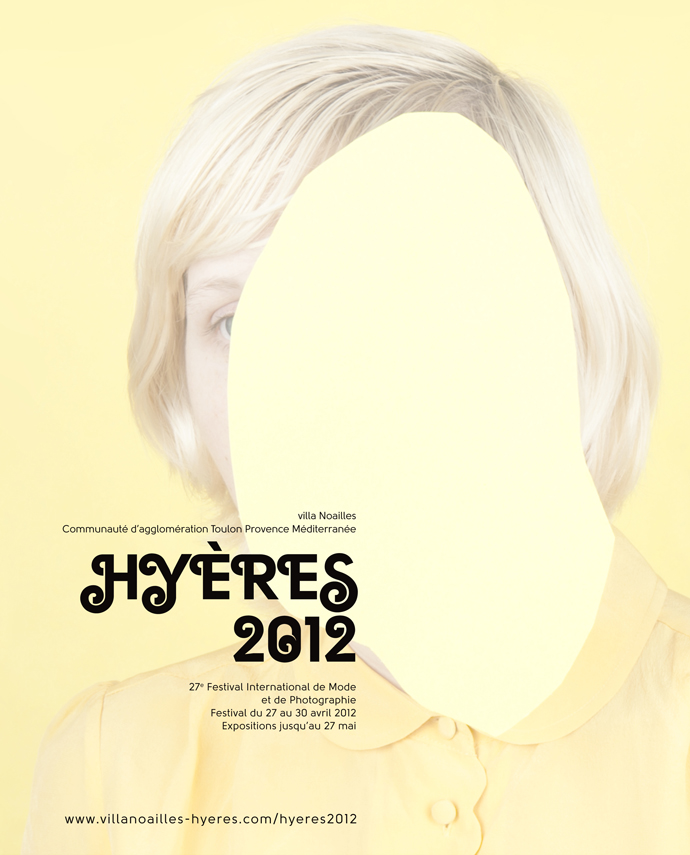 Hyères 2012 visual, featuring the work of 2011 contestant Ina Jang.
Hyères 2012 visual, featuring the work of 2011 contestant Ina Jang.Photographers, curators and critics met under the guidance of photography director Michel Mallard and his team on January 31st to chose 10 photographers whose work would be featured at the 27th edition of the Hyères Fashion + Photo Festival, a festival which revealed in the past talents such as Sølve Sundsbø, Cédric Buchet, Robbie Rodriguez, Caroll Taveras, Linus Bill and 2011’s winner Anouk Kruithoff.
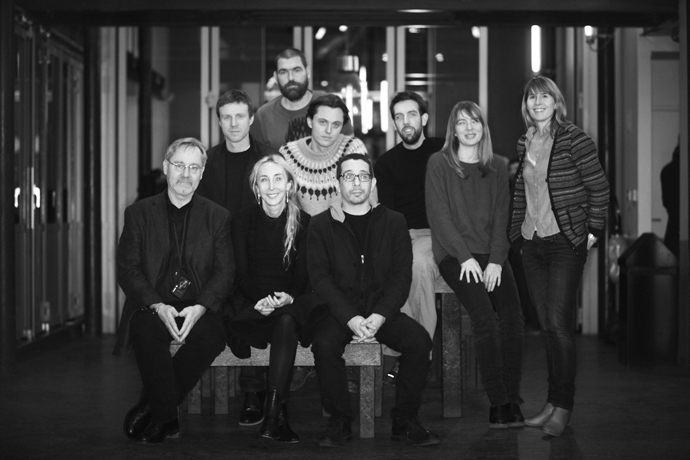 The 2012 photo jury, first row from left to right: Michael Wolf, Carla Sozzani, Michel Mallard,
Second row: James Reid, Aaron Schuman, Hans Gremmen, Raphaelle Stopin, Anne-Céline Jaeger,
Back: Jason Evans.
The 2012 photo jury, first row from left to right: Michael Wolf, Carla Sozzani, Michel Mallard,
Second row: James Reid, Aaron Schuman, Hans Gremmen, Raphaelle Stopin, Anne-Céline Jaeger,
Back: Jason Evans.So first they looked.
Then they talked.
And finally they argued.
And then they questioned their choice and started the process all over.
Until at last, they had 10 photographers, from 3 continents.Of course, come April 27th when the festival starts, these photographers will be competing for the jury’s attention, engaging in a series of one on one interviews and portfolio discussions in the Villa Noailles’ covered galleries, facing a cubist garden.
And yet the ability to spend quality time with high level professionals, to be exhibited next to the works of other 2012 exhibitions such as Inez van Laamswerde + Vinoodh Matadin and Jason Evans is a reward in itself…
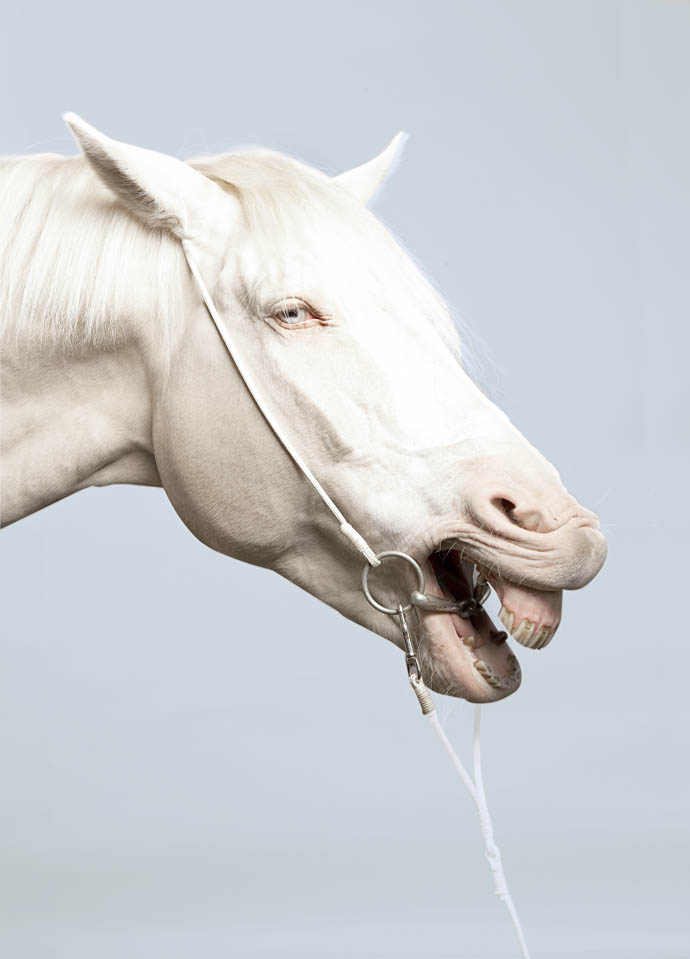 Photo by 2012 contestant Olga Cafiero.
Photo by 2012 contestant Olga Cafiero.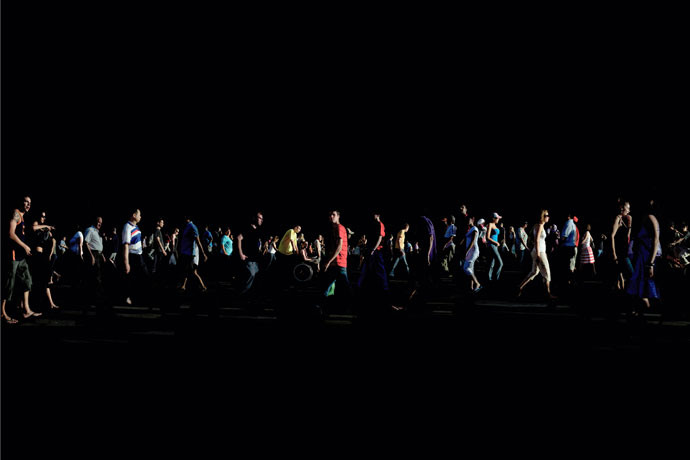 Photo by 2012 contestant Manuel Vazquez.
Photo by 2012 contestant Manuel Vazquez. Photo by 2012 contestant Brea Souders.
Photo by 2012 contestant Brea Souders. -

HYERES, IT BEGINS
-Can fashion still dazzle us ? To prove that the answer is “yes” for its 2012 edition, the legendary Hyères Fashion & Photography Festival has invited Yohji Yamamoto to preside its fashion jury…
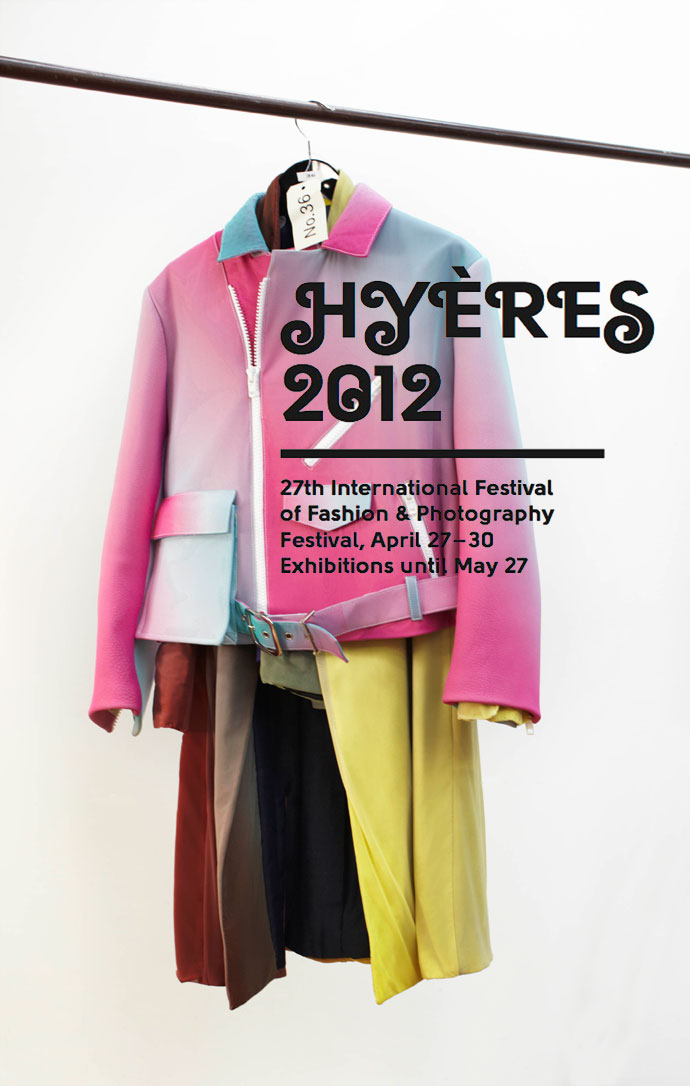
Leather Jacket by Daniel Hurlin, one of the contestants. Photo by René Habermacher.
There is problem in fashion today.
It’s a time of transition, adjusting to the internet, new markets, and the weight of conglomerates.
It’s a time of new opportunities for many.But it’s also a time where a house like Dior cannot find a replacing designer without causing a game of musical chairs – we are to understand that there are so few established designers out there, that Dior’s next womenswear designer must come from a competing house.
As if there were no young designers up to the job.
As if Galliano himself had had much experience when he started.
The problem is, today, that it’s become increasingly tough for young designers to develop their visual aesthetic independently, starting from scratch.
And if young designers can’t develop their style, be allowed to mature and establish themselves, well, there won’t be any mature designers around when Dior needs one.The submitted silhouettes of the 10 contestants. Photo by René Habermacher.
Luckily, there is Hyères.
Since 1985, the Hyères Fashion and Photography Festival, located on the Côte d’Azur in the South of France, has promoted the work of young designers by putting them in contact with the industry’s top professionals, organizing for them state-of-the-art fashion shows and drawing an audience of buyers and press from all over the world, giving them the chance to make a first impression.
Hyères has given us Viktor & Rolf, Felipe Oliveira Baptista (Lacoste), Gaspard Yurkievitch, and many others who now run the studios of the biggest houses.The Hyères 2012 Selection jury.
This Hyères (forgive the pun), Japanese designer Yohji Yamamoto has invited an all-star group to join him in the fashion jury: photographer Paolo Roversi, curator Jules Wright, Galliera fashion museum director Olivier Saillard, creative director Marc Ascoli, buyer Alan Bazarian, Hermès art director Pascale Mussard, and i-D magazine’s Terry Jones were all present to go through the dossiers of the applicants.
Jury member Olivier Saillard examining a dossier.
After hours of looking at dossiers and submitted looks, and additional hours of deliberation, the selection jury chose 4 men’s and 6 women’s looks from designers coming not only from traditional Western European countries but also from Australia, Canada, Argentina, Brazil, Finland and Estonia.
The designers now have 2 months to complete 6 more looks from their collection(and a special Chloé look) before flying in to Hyères in April and being prepped by fashion director Maïda Gregory for the jury and presentations, fashion shows and showrooms happening over the 3 days of the festival. In addition to a Grand Jury Prize (15 000 Euros by L’Oreal Professionel) and a Première Vision Prize (10 000 euros), they’ll also be competing for a new Chloé prize, with a specially designed look.
Photographer Paolo Roversi saluting us as he leaves the Yohji Yamamoto HQ. Photo by René Habermacher.
Check back with us soon for interviews of the jury members and news about the photo competition as well…
Hyères Fashion & Photography Festival
April 27-30th, 2012
Villa Noailles, Hyères, France -

HYÈRES is TOMORROW: RAF SIMONS
-“I do think the main thing when you start with what you want to do, is to find an audience.
And to find an audience, the main thing is to start up a dialogue with them and to find out what they want.”
Raf Simons speaks with The Stimuleye on Hyères. Contestants get ready for the next edition, register before 26th of November, and send your entry before the 5th of December!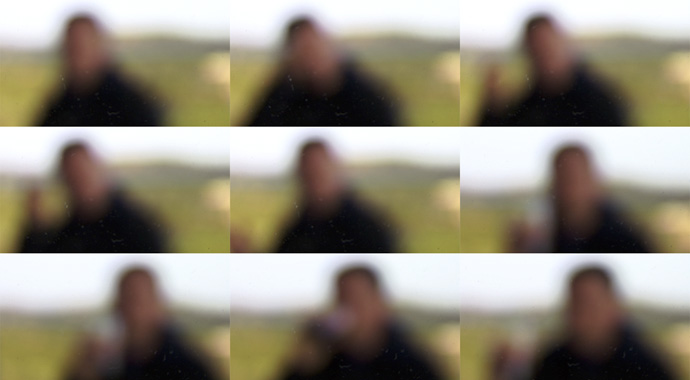 Mister Raf Simons likes it sharp but prefers his pictures in blur. Sequence by Antoine AsserafRAF SIMONS: With my exhibition at the villa, I wanted to show the form of extremity that can be the start of something and still be successful.
Mister Raf Simons likes it sharp but prefers his pictures in blur. Sequence by Antoine AsserafRAF SIMONS: With my exhibition at the villa, I wanted to show the form of extremity that can be the start of something and still be successful.To me it’s really important for the generation who enters into this context to realise what kind of platform this is. I think it’s enormous. The amount of press that is there and the staging of the garments on a super high level.
We selected 10 contestants out of 50 (of initially 800 entries), together with Christopher Kane, Michel Gaubert, Maida Boina and Jean Pierre Blanc.It was not easy. We had for each entry one single silhouette, which is complicated to judge with the dossier that is “flat” and has yet to be developed.I did see there were people who were working on their collection, from the moment they were chosen to the moment it went on stage, and there were people who did not. That showed also in the final result: the ones who had been working on, got better.
It was quite a discussion within the jury. We were not unanimous about the winner. There were mainly two, but there was clearly already a third person [Emilie Meldem] that all members of the jury found interesting to mention, so we had to decide to vote, which is also the honest way I think. when you start discussing like “yeah maybe less people like that and more like the the other, but let’s still make the winner the one that less people like”- I think that is not correct.Hyères Alive - Award Ceremonies
“Refined sensibility” – I think the winner [Léa Peckre] stood out for that at the end.
The second price [Céline Meteil] won for its purity. In relation to lots of other things the jury members thought that one was attracting because of the purity and of its honesty: to take one thing and kind of concentrate on that. One material, one process, one kind of shape. But it worked. It had something quite controlled at the same time something not too forced, not trying to be too special. Because we had quite some people who tried to be really special and it also went wrong. -

Hyères We Go Again
-Ladies and gentlemen, place your bets. Every year, the Villa Noailles art center in Hyères, France offers fashion designers and photographers the opportunity to step into the spotlight…
Photo by 2010 photo winner Yann Gross, look by 2011 fashion winner Léa Peckre.
Design duo Viktor & Rolf ? Stills photographer and Ricard award finalist Erwan Frotin ? Mugler men’s designer Romain Kremer ? Fashion photographer Sølve Sundsbø ? ANDAM 2011 prize winner Anthony Vaccarello ? Lacoste designer Felipe Oliveira Baptista ? All these people have one thing in common – their work was all launched into the spotlight through the Hyères fashion and photography festival, which is now going into its 27th edition.
As a contestant, you must register by November 26th and send your application package by December 5, 2011. Your work will then be reviewed by a jury of fashion, art and photography professionals (including in the past Azzedine Alaia, Nan Goldin, Riccardo Tisci, Peter Knap, Karl Lagerfeld, Viviane Sassen, Dries Van Noten, Tim Walker, Christian Lacroix…).
If you make it past the first rounds of selection, you’ll be given production help for your collection, flown to the Hyères, given the chance to meet and talk with the 2012 juries, and have the famous Hyères team produce a gallery show of your pictures or a fashion show of your collection, in or around the unique setting of the avant-garde Villa Noailles, once vacation home to the likes of Dali and Cocteau…
And of course, the best part: my little finger tells me this year there will be even more prizes…
In case that wasn’t enough, here’s everything you need to know about Hyères in 2 minutes 6 seconds.
Villa Noailles
2012 Contest guidelines & registration
Registration deadline: November 26th, 2011
Submission deadline: December 5th, 2011 -

the shoes
-They’ve produced Shakira, Sha-Sthil’ed, released a secret Japanese album, toured Europe, and now they’re preparing their big Paris concert, before continuing more collaborations with WoodKid, Aikiu and Philippe Katerine. Ladies and Gentlemen, take your socks off for…The Shoes.
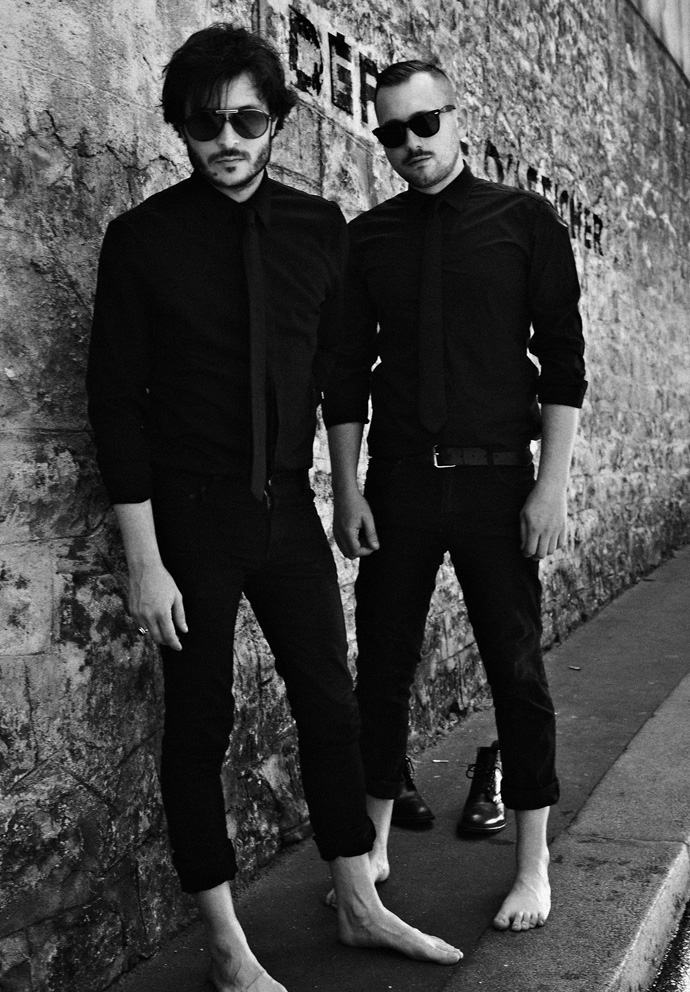 Benjamin (left) and Guillaume (right) of The Shoes, photo by René Habermacher.
Benjamin (left) and Guillaume (right) of The Shoes, photo by René Habermacher.You guys DJ’ed at the Hyères Fashion Festival, then at Versailles for the end of Couture Week, are you infiltrating fashion ?
It was a fun DJ set, a bit camping/bar mitzvah, but well mixed.
We also played in Florence for Pitti, in a beautiful place.
Are you continuing to do production for other artists?
Benjamin: It’s a part of our identity we started and really want to develop, so we try to keep it going, in between festivals, concerts and other requests that come in. We’re working on the WoodKid (Yoann Lemoine) album, a track with Philippe Katerine, very different things as long as we like the artist.
Guillaume: With Yoann it’s a bit different, as he’s also a friend.
How long has your album been out – you seem to have a lot of different videos already ?
B: The album came out in March, I think like Mylene Farmer we’re going to make a DVD with all the videos… (laughs)
G: We’ve done 4 videos already, preparing Time To Dance for the fall. In the end half of the album is going to have videos.
The Shoes ft Esser, STAY THE SAME. Directed by Daniel Wolfe.
Is Cliché one of the tracks for which you’ll make a video ?
G: a lot of people have asked, it’s a track that chicks like a lot because it’s the only feminine voice on the record, but it’s not in the plans right now, we think Time To Dance will work.
B: We’ve seen people go crazy on that track even though it hasn’t been played much. It has an old-school, Underworld-style crescendo that lasts 2 minutes.
I’ve seen you at the Nouveau Casino the first time around…do you manage to get some of the singers from the tracks to come sing from time to time ?
G: that was really at the beginning! We have Ben Esser who comes quite often, Anita from Cocknbullkid came at Nouveau Casino. But of course the audience likes to put a face on the song.
It’s a bit unusual to have the lyrics pre-recorded with live instruments, usually it’s the other way around — live lyrics with instruments playback. Especially because you guys really are hardcore on the instruments, while the voice seems to come from nowhere…
B: that was the main criticism aimed at us at the beginning, and we hadn’t solved it when you saw us.
G: we were a bit shy, now we sing it ourself, it’s not perfect but it works more with energy instead. Now we’re starting to more or less control the singing.
The Shoes performing WASTIN' TIME with Esser at Hyères 2011, with Stage of the Art.
Do you sing it entirely live now or do you mix with the recorded lyrics by the singer ?
B: you’re getting into our trade secrets… we mix the voices actually.
G: we don’t try to hide it. it was a problem at first, but now we’ve worked it out – though of course when someone like Esser comes along it’s great, it gives it more of a band feeling and we can concentrate on instruments.So how did you choose the singers and bands with which you collaborated ?
G: it happened by itself.
B: we were spending time in the UK, we met lots of people, making friends. It started with Primary One, we did the music for the track People Moving, he came to the studio in Rheims and we realized we could never have this kind of result with our own voices, so it became our first featuring. Then we contacted the people we had met with some demos, sometimes with lyrics sung in “yogurt”. No real name dropping.
G: none of the featurings are very famous people, it’s rather people who are at a similar stage of their career… since then we see a lot more Cocknbullkid and Esser.Singing in French, is that something you’d consider ? I imagine the collaboration with Katerine is in French ?
B: for The Shoes, no, but for other artists we do it.G: Benjamin does it more than me, but it’s not something for The Shoes yet.
The Shoes performing STAY THE SAME with Esser at Hyères 2011, with Stage of the Art.
What’s the current program, festivals ?
G: [this summer it was] festivals, the WoodKid album.
I’ve also produced the album of this artist called The Aikiu, which is a complete transfiguration of the initial project.
Is that the first real album by The Aikiu ? It seems it’s a project that has been on the verge of happening for a long time, I remember hearing a single at least 5 or 6 years ago…
G: They’ve had EP’s only so far, they asked us to come work on the album, we arrived and blew the whole thing upside down. We broke everything and started from scratch. I think Alex has a great voice, and that there’s great things to do with his voice — but that’s complete now and we’re working on WoodKid.
And working on WoodKid’s album brings some extraordinary conditions, we get to use unusual instruments. Yoann also puts a lot of constraints on us too, he knows what he doesn’t want, which pushes us to do things in different ways.
I was also very happy to discover that you (Guillaume) were behind Gucci Vump and the track SHA SHTIL which was THE track of the summer last year… Is that something you’ll continue or are you focussing exclusively on The Shoes ?
G: I’m focussing more on The Shoes, but Gucci Vump is a funny project, a bit shapeless, Louis (Brodinski) and I run into each other from time to time, we get commissions for remixes from time to time — like WoodKid’s Iron. It’s a dilettante project.
Gucci Vump – Sha! Shtil! by quepasooo
So after the festivals you guys are focussing on your own tour ?
G: Yes we have over 30 dates in the fall, the climax will be November 9th at La Cigale in Paris. We also hope to return to Japan.
You’ve already played in Japan ?
G: The album did really well over there, Japan’s the first country to sign us besides GUM, and they didn’t want to wait so long for the album, so we released an album just for Japan, with B-sides. People try to get their hands on that album, which is a bit of a collectors’ item, with demos and beta versions of tracks which later appear on CRACK MY BONES.
But we’re very focussed on our La Cigale date – with almost all the guests from the album, extra band members…
We usually have 2 percussionists, but we’ll probably go back to 4 – visually it’s beautiful and in terms of sound it doesn’t hurt. When you have 4 guys doing a sort of choreography, it gives something unusual.
The Shoes, photo by René Habermacher.
The last thing which stimulated you…
G: a DJ from a rap group called 1995, a French group, which made an amazing mixtape for the summer.
B: for me, it was the Solidays concert of Ebony Bones – I usually don’t listen to her music, but in concert it was impressive. It’s really made for a festival.
G: from time to time, you get groups that you don’t necessarily like that make a strong impression on you live, they transfigure their music. But you also get the opposite…
I had that with Gonzales. 10 years ago I liked his stuff, I went to see him live, and I hated it so much, I couldn’t listen to the music again for several years. And still now I like the music but I can’t stand his videos or his imagery in general.
G: it was really important for us to delegate the image to Pierre (LeNy), even if we have our ideas regarding what we like visually.
So far you haven’t appeared in any of your videos….but you’re not hiding either ?
G: You often see beautiful videos that fail as soon as the singer appears, the acting required from the singer brings the whole thing down. We want our films to be little bits of cinema – we’re not going to add anything to that feeling.
THE SHOES
Special concert at LA CIGALE
November 9th 2011
Opening act: ESSERPhoto credits:
STYLING: Michael Philouze
GROOMING: Tanya K @ B-AGENCY
PHOTO ASSISTANT: Fabien Campoverde
with special thanks to Pierre Le Ny & G.U.M.Film credits:
Filmed by Jason Last & René Habermacher
Edited by Antoine Asseraf
Production Assistant Lynsey Peisinger
a THE STIMULEYE production -

MAREUNROL’S
-Mārīte Mastiņa and Rolands Pēterkops, the minds behind fashion brand MAREUNROL’S pulled their strings for the installation TENANTS which just closed at the Villa Noailles in Hyères, France. The Latvian duo from Riga had already won the two biggest prizes at the Hyères fashion festival in 2009, made a stunning return fashion show in 2010, but his year’s exhibition proves not only their virtuosity in fabricating elegant and wearable pieces of clothing, but also their ability to create a much broader, often dark and poetic universe.
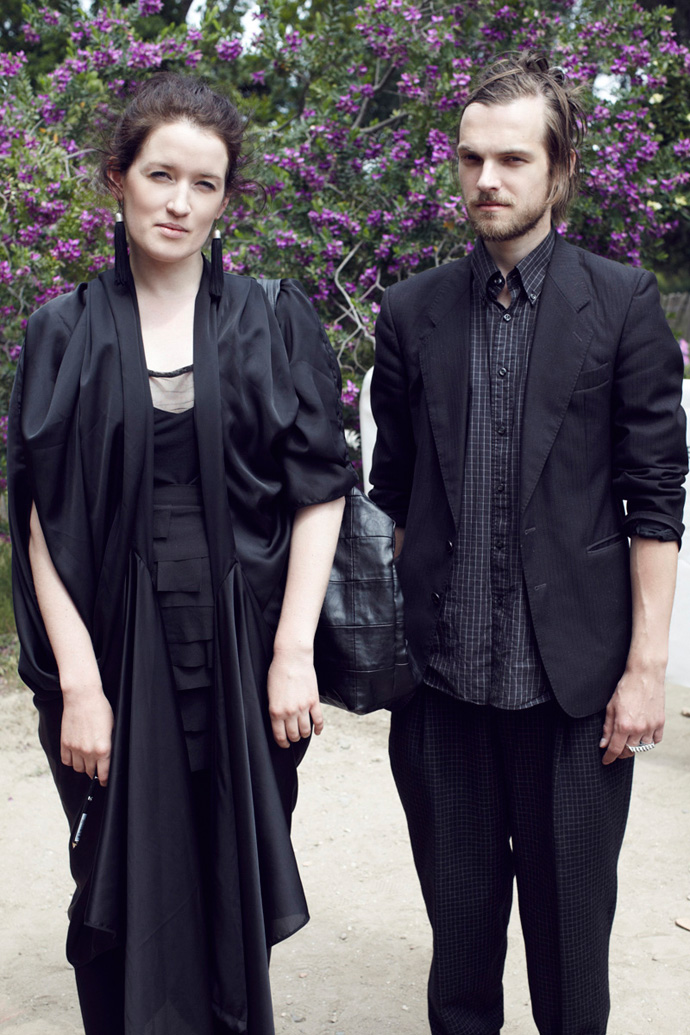 Mareunrol: Mārīte Mastiņa and Rolands Pēterkops at the garden of the villa Noailles.
Mareunrol: Mārīte Mastiņa and Rolands Pēterkops at the garden of the villa Noailles.RENÉ HABERMACHER: what was the point of departure for this installation and the inspiration behind it?
ROLANDS PETERKOPS & MARITE MASTINA: When we start to work on a new collection, we always make the designs first to fit on miniature mannequins. And each time we both have discussed the idea of beautiful dolls as models so we could our ideas of garments to shoot as small style photos and to show them as the newest collection. That is why this idea came naturally.The advantage of the small scale is that we have the freedom of implement anything, all our ideas without leaving out any of those costing an absolute fortune to make. Visual inspiration came in recent years moving from one apartment to another. That’s why our project is called TENANTS. As any of our works, this work also reflects our experience.
The inspiration for the installation came from artists’ constant moving from one apartment to another, from one neighbors to others, from one room to next and due to moving to new environment always makes you get used to new mystical noises, strange objects, loud or too quiet neighbors and other peculiarities connected with the apartment. But of course, with time you get used to all that. However, that all provoked thinking of how space influences those living in it and vice versa, and whether all these things in one way or another influence people and whether one imperceptibly starts to change, and whether this oddity is just in one’s mind, not reality. This is how emerged the idea for the installation with people/ tenants who dwell in their apartments and become as one with it. All their belongings are like a huge enormous shell/ attire which tell all their peculiarities, interests, specific hobbies and many other things.
These stories are made as small installations which show short sketches from character’s daily life. They communicate through costumes, scenography, sound and light. It is important that not only costumes and puppets are made for the installation, but also environment/ scenography, where they can express themselves and show the intended story, by forming a figurative composition which is combined with a surreal fantasy, mystique and a pinch of wit.
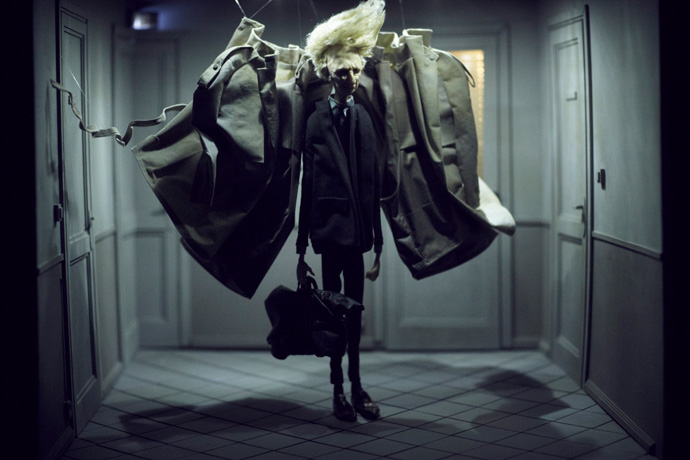 Mārīte Mastiņa and Rolands Pēterkops: Tableau from the exhibition TENANTS.
The dolls character is inspired and modeled after Keith Richards.
Mārīte Mastiņa and Rolands Pēterkops: Tableau from the exhibition TENANTS.
The dolls character is inspired and modeled after Keith Richards.Can you explain me the process of planning and making the installations?
First we had a few visions of the project, then we started working on sketches slowly crystallyzing the characters. At the same time we started looking for people who could make the puppets we had envisaged. It was really important for us to find a puppet master who could make the dolls with movable head and arms. It is really important for our Prague project.
(more…) -

ERWIN BLUMENFELD: through the eyes of his son Henry.
-On the second day of the fashion and photography festival in Hyeres, I watched Henry Blumenfeld, elementary particle physicist and son of Erwin Blumenfeld, inconspicuously walking through the exhibit of his father’s work at the Villa Noailles. He was wearing a tan suit, sneakers and a baseball cap that was slightly crooked on his head. Before long, the spacious, bright room where the artist’s photographs and videos were being exhibited became empty and quiet. Only the slight hum of voices around the villa could be heard through the walls. Here, surrounded by a collection of stunning and rare examples of his father’s work — large-scale, restored prints — Henry sat down with us for an intimate conversation: Erwin Blumenfeld the artist, the father, the mentor and the man of perseverance.
by Lynsey Peisinger, Photography René Habermacher
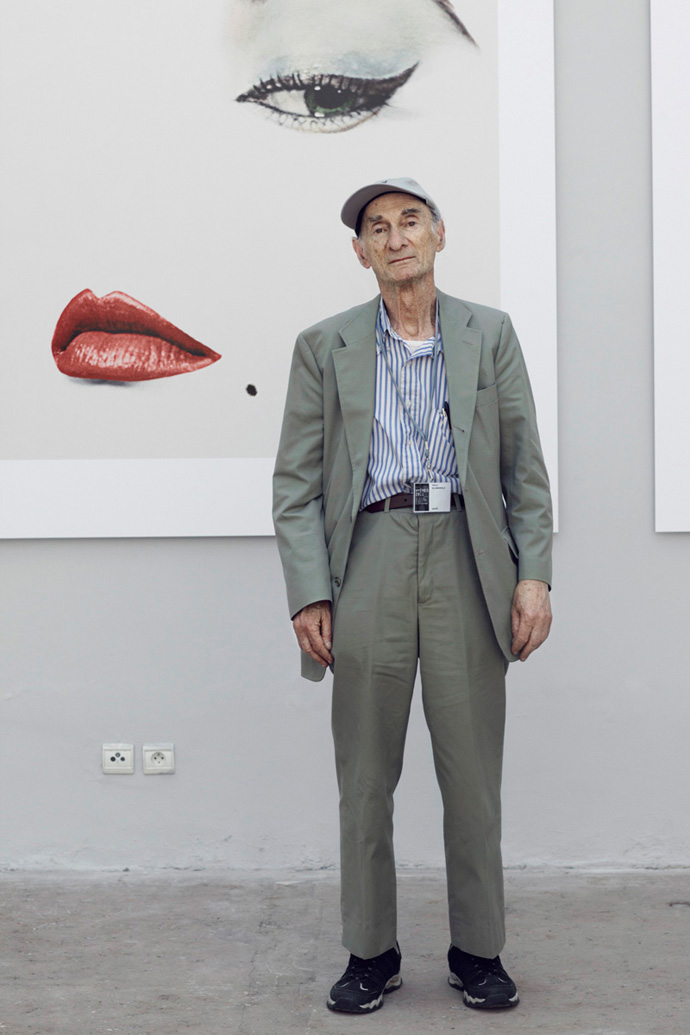 Son Henry Blumenfeld in front of his fathers DOE EYE with Jean Patchett for Vogue US 1950
Son Henry Blumenfeld in front of his fathers DOE EYE with Jean Patchett for Vogue US 1950LYNSEY PEISINGER: Where were you born?
HENRY BLUMENFELD: I was born in 1925 in Zandfoort near Amsterdam. My father had been an ambulance driver during the first World War. During the war, he had met my mother who was Dutch, Lena Citroen, who was a cousin of Pal Citroen, a German/Dutch artist. He grew up in Berlin with my father and they went to school together and they were very close friends. Through Pal, he met my mother and they corresponded during the war. My mother came to visit him in Germany when he was a soldier there. He tried to leave Germany, but he couldn’t. So, just after the war he came to Holland and then, a little bit later, married my mother in the early 20s. I guess, 1921. And because he was German and she was Dutch, she became German — that was the Dutch law at the time. I was born in Holland, but because I had a German father, I also became German.
LP: What was your father doing at that time?
HB: He was surviving. Leaving Germany at the end of the war, he tried to survive with the help of my mother and set up some kind of art dealing business with a friend, but that didn’t work very well. He was doing a lot of collage and kept in touch with other German Dadaists. After two years, he started to work as a clerk in a department store. Later, around the time I was born, he opened his own shop called the Fox Leather Company, selling ladies handbags and suitcases on the Kalvestraat. That went fairly well, but soon Hitler came to power and the business went badly and eventually bankrupt. That’s when he decided to become a photographer in 1934.
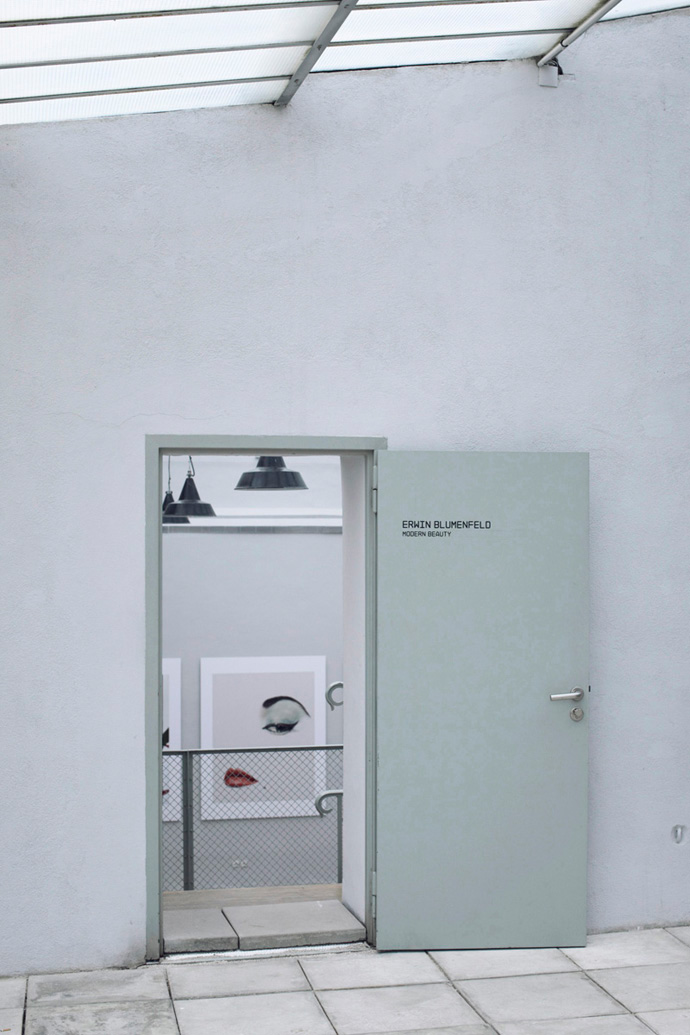
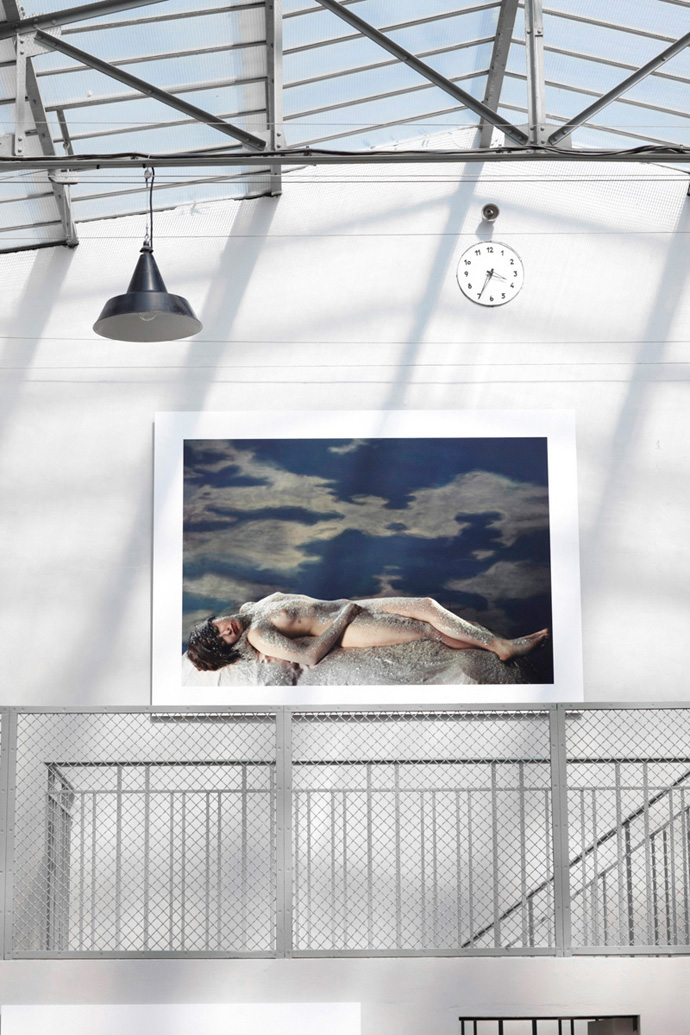 ERWIN BLUMENFELD Exhibition at the villa Noailles Squash Court. Right: Erwin Blumenfeld OPHELIA 1947
ERWIN BLUMENFELD Exhibition at the villa Noailles Squash Court. Right: Erwin Blumenfeld OPHELIA 1947RENE HABERMACHER: So your father’s first art oriented interest was collage and he was in the Dadaist movement?
HB: He was already interested in photography. He got his first camera when he was about 6 or 7. But his main interest was perhaps the theatre. That was something he was strongly attached to: the German language. His Dutch always remained a little bit feeble to say the least. He worked quite a lot, but with theatre in German language, he couldn’t make much of a living… With his collages he couldn’t make a living with that either but always kept in touch with the Germans — Grosz and Richard Huelsenbeck and other people of the Dadaist movement. Recently there was an exhibition in Berlin on this periods work of my father and a book has been published.
LP: Did he continue to do collage later on when he started doing photography?
HB: No. When he was doing collage, he was also painting — he was a Sunday painter: He did quite a bit of painting on Saturdays and Sundays. But he dropped doing his collage and the painting and started doing photography in Amsterdam. The business went rather poorly, he had health problems and more or less escaped to Paris around the 1st of January 1936. The first year it was very difficult for him to make a living. He got support from the family of his wife, of my mother. On his side he didn’t have much family left. His father had died before the first world war and his mother deceased shortly afterwards. He lost his brother in the war as a soldier in the German army and his sister died of Tuberculosis shortly after.
My father was friends with Walter Feilchenfeldt’s wife Marianne. He was a quite well known art dealer in Zurich. Mariane Feilchenfeldt helped him to rent his studio in Paris at 9 rue Delambre.
RH: So in Paris he got introduced to photography on a professional level?
HB: Already in Holland he was doing it on a professional level. He took many portraits and pictures there, but they didn’t sell much. He got in touch with some French people who came to Holland and they eventually supported him when he went to Paris — like Andre Girard the painter. Then, after about a year later, he started to sell photos to small photo magazines in the US and England, such as Lilliput. In 1937, he met british photographer Cecil Beaton who introduced him to Vogue. My father started to work for Paris Vogue in 1938.
When he was in Paris, he worked only in black and white. Color was not yet really developed for photography. It was very difficult for individuals to use color in their own studios, so he only did black and white while he was in Paris. I should mention that for his Paris period, his publications in Verve were very important. He had some of his striking black and white photos published in the first issues of that magazine. In the dark room, he experimented a lot, but only in black and white.
Then came the war and during the war, we were foreigners in france — we were not really refugees, but were without status, so it was quite difficult. In the beginning of the war, we were more or less exiled, we lived in a hotel in Vessely nine months, a sort of medieval town in Burgundy, France with a really nice cathedral. Then the Germans came and my father and sister were put in a camp. My mother and my brother and I, with the help of some Citroen cousins, managed to escape to the south of France. Our father was then in a rather horrible camp in France. We stayed in the Country until 1941, trying to get out. Then we managed to get a visa for the US — my father had been to the US already, in June of 1939. That was were, I think he took his first color photographs. He came back to France in July 1939 and he was stuck in France for two years. Then when we got to go to the US, he started working first with Harper’s Bazaar for two or three years, switched to Vogue and started doing color photography. At the time, he took his color pictures in the studio, using different color lights and so on — he was very experimental. But for the development and the printing, it was completely out of his hands. It was always done by Kodak. At the time, he couldn’t do anything in color on his own in the laboratory.
Most of these photos here were printed by Kodak. When I say printed, they weren’t really printed, they were large color transparencies. Like big negatives — 12 by 15 inches. I think that all of these photos here were taken in this large format and they were transparencies. The pictures were only printed for Vogue — working from the transparencies. Sometimes my father would give some direction on how they should be printed, but he was not generally involved in the printing itself. Only later, around 1956, they started to develop a new process called C-Prints. He bought the C-Print machine and he could start doing his own color. But C-Prints were very unstable as far as the color went — if they were exposed to light, in a few days they would essentially vanish. So all of his work in C-Print is essentially gone. Even the color transparencies that we have of his work have either faded or changed color a lot. Especially the reds, had faded. So, our doughtier Nadia has worked a lot with Olivier Berg at a laboratory in Lozère to try to restore the original colors. She is using the original publications because those prints have kept their color much better than the transparencies. So what you see in this exhibit is the result of the work that Olivier Berg and Nadia have done.
RH: Would you say that your father was somebody who was very progressive and pushing for new things in general?
HB: I don’t know about new things…. He was for the experimental, which is a little bit different. I don’t know if he was really striving for new things, but he tried to do do things differently and experimented. He was very much inspired by especially old painters like Goya and Renoir and much impressed by Picasso. I don’t know if he ever got to meet Picasso in Paris at the time. But he met quite a few artists as Dali and others.
 Erwin Blumenfeld advertising for PALL MALL circa 1957.
Erwin Blumenfeld advertising for PALL MALL circa 1957.RH: But he liked the experimental, so maybe that was something that remained with him from the Dadaist movement?
HB: Yes, that was important to him.
LP: I heard Michel Mallard talking earlier about how remarkable it is that there was no photoshop or digital editing at that time… this image, this one with the lips and the eye, DOE EYE, where the nose is missing and there is color separation, was this done in the retouching process?
HB: This was done in the process of retouching. It was an original black and white picture. It was colored afterwards by my father and by Vogue. They worked on it together. That was a special case because the others that you see were done in color and then reworked. This one did not originally have these colors.
RH: When your father was working, did you often witness his process and how he worked in his studio?
HB: No. When he was in Paris, working in black and white, I was somewhat present. But afterwards, in the States, I was not really present anymore. So I didn’t really witness him working in color.
RH: Was his approach as a photographer more controlled or more spontaneous?
HB: I think both. He was quite controlled — all of these pictures here were taken in a studio. But he also traveled quite a bit in America and in Europe and he took many 35 millimeter color slides. Incidentally, the color of those slides kept much better than the color on the transparencies. But, in the studio, he was very controlled and would take many pictures to get something specific in a sitting.
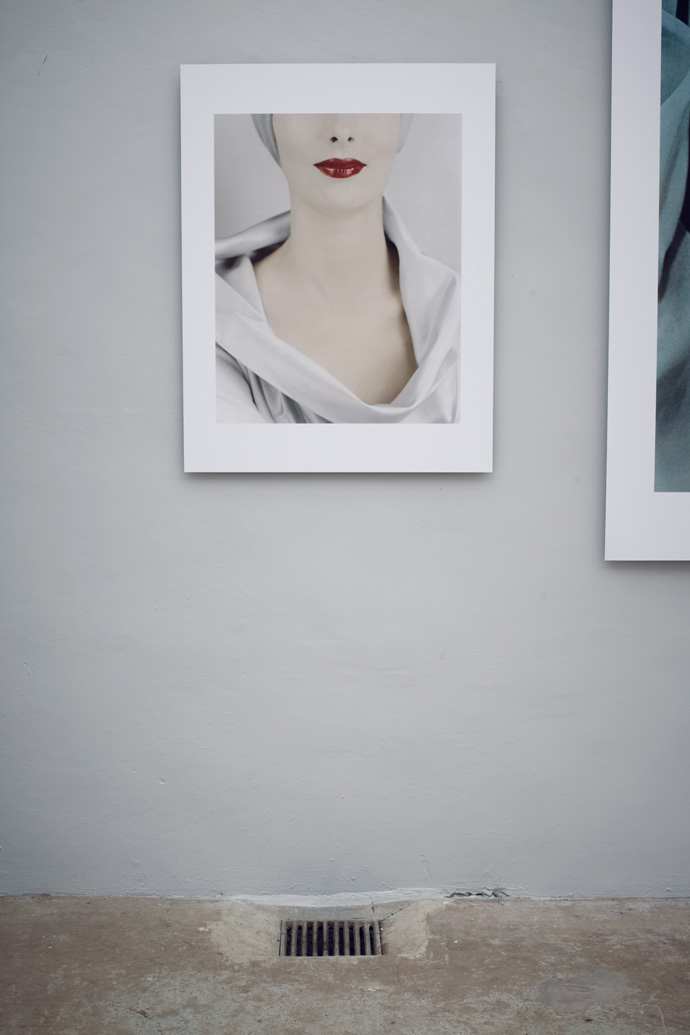
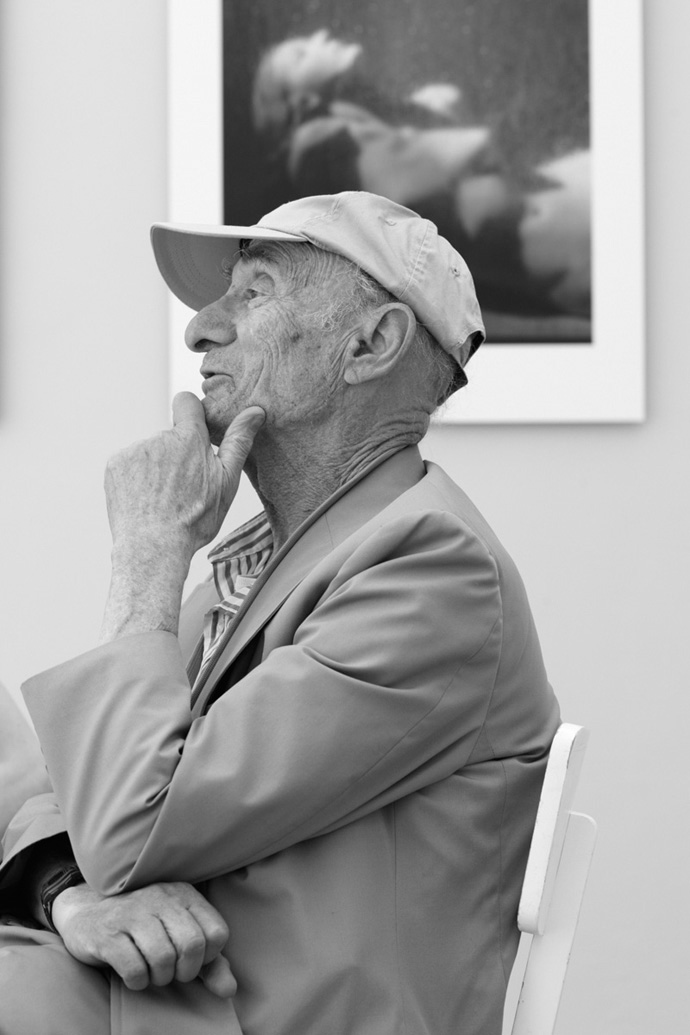 Left: Erwin Blumenfeld LE DECOLLETE 1952, RIGHT: Henry Blumenfeld in Conversation
Left: Erwin Blumenfeld LE DECOLLETE 1952, RIGHT: Henry Blumenfeld in ConversationLP: In Paris, were you present when he would shoot people in the studio?
HB: Sometimes, but not very often. I was more present when he was working in the dark room.
RH: I recently saw notes from Richard Avedon where he had a black and white print and he marked on it all of the places where he wanted the development to be darker or lighter using manipulation techniques in the dark room. Was your father working with these techniques too?
HB: Yes in the dark room, for black and white, he manipulated a lot. It would have been interesting to see what he would have done with color photography if he had been born fifty years later. At the time, the technology wasn’t there for him to do anything after a picture was taken in color.
RH: Where would your father have his intellectual and creative relationships — in other photography or painting etc?
HB: I would think painting. Very much painting, classical painting. Many of his photos were inspired by different painters. He was also inspired by modern life and by life in NY at the time, in the 40s and 50s. He liked jazz music very much, in the New Orleans style.
And he was quite interested in looking at television when it first came out. We got our first television set around 1950 or so. It was black and white at the time. I don’t think he ever saw color television. Maybe he saw it, but he never had one. He liked movies — but more for the content than for the photography. He liked Nanook of the North, about a Danish explorer. He was interested in movies — liked Erich Von Stroheim and he liked Sunset Boulevard and Billy WIlder.
RH: Was that love for cinema also what led to him making films?
HB: The filming was more in line with advertising. I think he was trying to see if he could use the filming for advertising, rather than to tell a story like in movies. Now you see everything mixed, advertising and movies. But at the time, it was an experiment.
RH: Do you think that your father really divided the things that he did for himself and the things that he was commissioned to do? The time after the war was quite commercial driven in America — was it easy for him to also do what he wanted to do?
HB: For one thing, the black and white and the color were two different things. In black and white, he could do what he wanted. In color, probably none of them were published in the exact way that they had been taken. They were made and developed specifically for Vogue. He did appreciate the possibility to work in color, but the whole fashion business and the way it worked was not very attractive for him. But still, when he had started out in Germany, he had started out working for a textile company and so, even then, he was interested in materials and fashion. Still, he didn’t really appreciate the fashion magazine business, but he knew that he could make his living there. So there were two sides to it for him — on one side, it was a place for him to make a living, on the other side, it gave him the opportunity to work in color, which he might not have had otherwise. He did have certain resentments, which is true for everyone in any job.
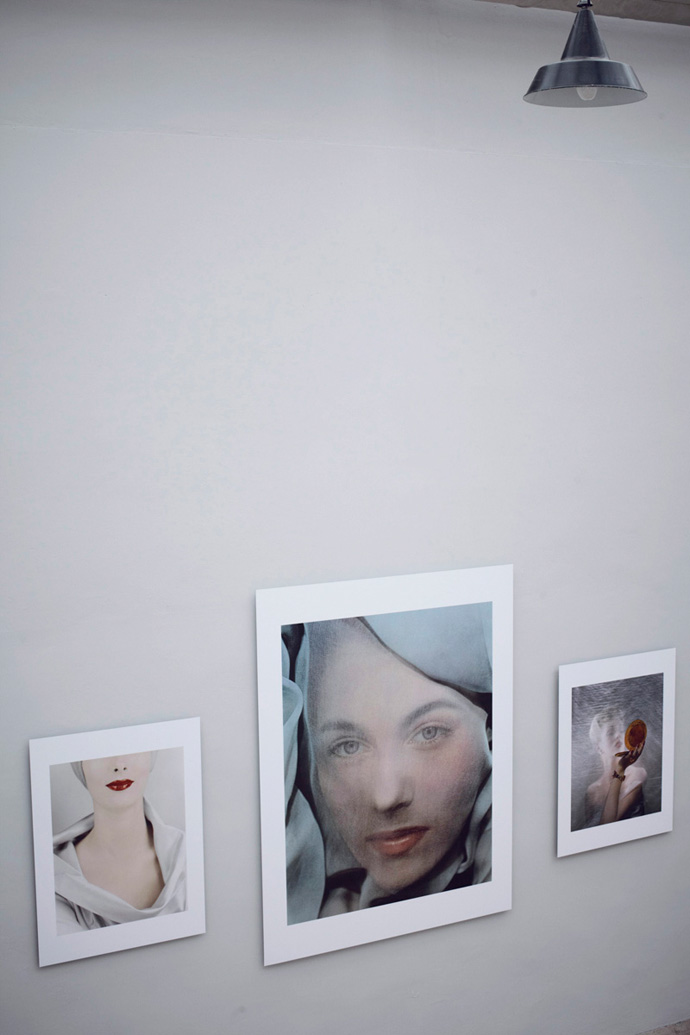 Erwin Blumenfeld DECOLLETEE and BLUE both 1952, and POWDER BOX 1944
Erwin Blumenfeld DECOLLETEE and BLUE both 1952, and POWDER BOX 1944RH: There are artists who suffer between the economical need to do something commercial and the desire to make the work that they are passionate about. They can feel torn…
HB: I don’t think that was his case. First of all, he did well financially in the 40s and 50s and he appreciated that. And then, because of that he was able to continue his work in black and white. You might have seen his book “My One Hundred Best Photos”. We have people comment on the fact that there is almost no fashion in that book–he did a little fashion photography in black and white for Vogue before the war, but later he didn’t do any fashion work in black and white. But, it gave him a lot of satisfaction to be able to do that book of his black and white work.
Still…he wasn’t always satisfied with everything. Becoming old for him was very difficult. It made him suffer a lot…some people accept it, but he accepted it quite badly.
LP: You said that he was experimental as a photographer. As a person and as a father, did he also have that type of attitude? And did he transmit that type of approach to his children?
HB: Well….I think he had his ups and downs. He was a very active father in many ways. He was involved with his children and either pleased or displeased with what they were doing. I don’t know….the children turned out very differently. I became an elementary particle physicist. My brother became a writer. He is not exactly politically minded… he is interested in art, sociology in many ways and in the way people behave. He was very rich in ideas my father, perhaps more so than his children.
LP: Did any of his children take an interest in photography?
HB: Interest yes, but not active in photography. Though, my wife became a photographer. She was born in Paris to an Algerian/Russian father and a British aristocratic mother. She survived the war in France — her father was Jewish, her mother was British, but anyway they would have liked to capture her. After the war she came to New York and worked for one year for the New York Times, one of the first women to work in a non-secretary position at the New York Times. Then she went back to France and when she came back to the States, the New York Times fired her because her vacation to France was more vacation than they were willing to give. Then she met the wife of Alex Liberman, the editor of Vogue, and became model editor at Vogue. Her job was to provide models for the photographers. Then she met my father and after a fews years, she started working for him. She started representing him. She never got any lessons from him in photography but she worked with him as an assistant– sending his photographs to different commercial companies. Then after we got married, she became a photographer herself and worked quite actively as a photographer. First a bit in Princeton where we lived. Then in Geneva for a few years. Then we came to Paris and she started working for Vogue and other magazines. She did mostly portraits of personalities and important political people and scientists etc. And other side projects, like children photography too. To a large extent inspired by my father. Of course, after we got married and had children, my father got another assistant, Marina Schinz. She became a photographer too — mostly garden photography and published a book on that.
LP: It is interesting that she worked with your father, who was doing a lot of fashion photography and then she became a garden photographer…
HB: She admired his work very much and when he died, she bought his studio on Central Park South. And she didn’t have a single photograph of his on the wall.
Both she and Kathleen, my wife, probably wouldn’t have become photographers without him. They were inspired by him, but they probably felt that they couldn’t really rival him, so they chose different styles.
LP: Do you think that he was a good teacher?
HB: He wasn’t really a teacher. But he was a big influence. My wife saw how he worked, but he never tried to give her lessons. Same with Marina Schinz.
When my father died, he let Marina handle his photographic inheritance. From the point of view of his will, it was never very clear…He left the photos with her and she tried to handle it the best possible way. So she divided all of the black and white photographs into four lots–one for each of his children and one for herself. Then she gave essentially all of the color transparencies to Nadia. Now Nadia has been quite active in promoting her grandfather’s work. She is now working on an exhibit for next year in Chalands sur Seine. There is a photography museum there and next year they will do an exhibit of my father’s work.
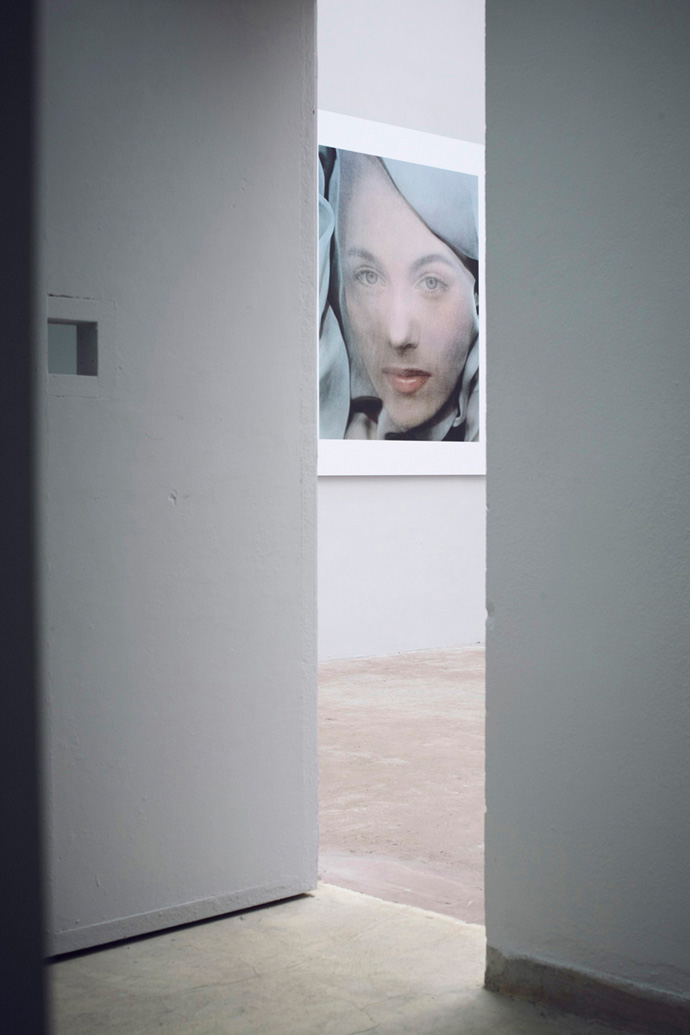
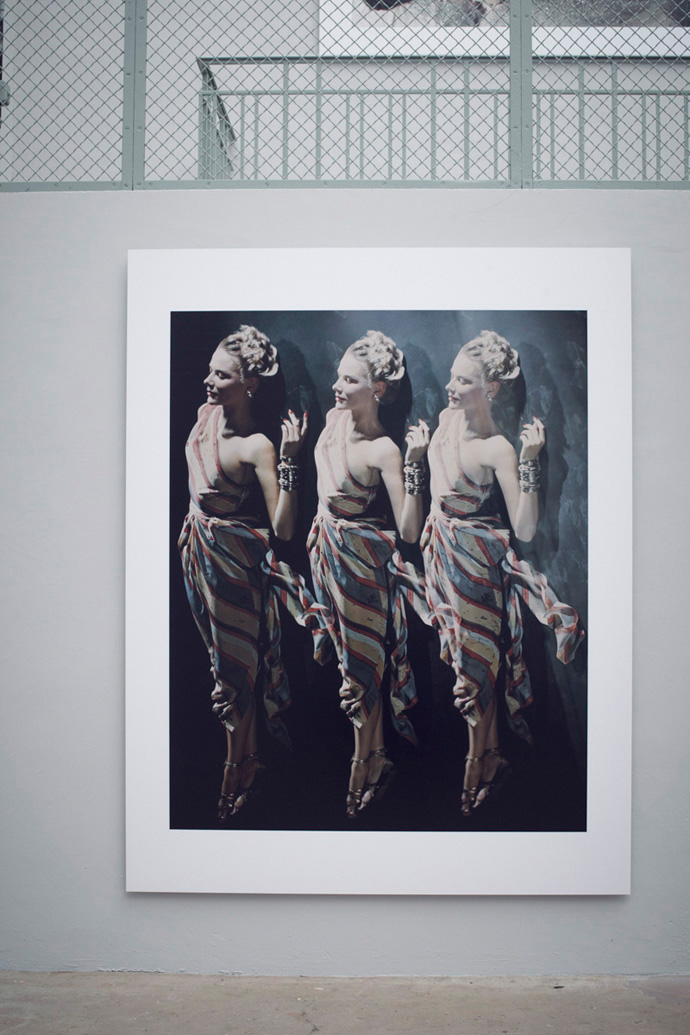 Left: Erwin Blumenfeld BLUE with model Leslie Redgate 1952. Right: Erwin Blumenfeld VARIATIONS, unpublished 1947
Left: Erwin Blumenfeld BLUE with model Leslie Redgate 1952. Right: Erwin Blumenfeld VARIATIONS, unpublished 1947LP: What is the last thing that stimulated you?
HB: What do you mean by stimulated? Something that affected me? Well, the thing that affected me is that my wife, Kathleen, died three months ago. Clearly that affected me. She had been sick, her brain didn’t work anymore. She was going downhill for ten years and in the last two years, she didn’t talk anymore. I don’t know what went on in her head. And three months ago, on the 9th of February, she died next to me…That is the thing that affected me. Also, what affected me was, she died very peacefully next to me. I didn’t realize that she was dead until I felt her and she was still warm and the kin came and said “votre femme est morte”. The morning afterwards, I got the announcement that a second great grandchild had been born. That also affected me. The day afterwards was the funeral and that was quite a moving event–we had five of the grandchildren and they made speeches and my children made speeches and I made a speech. One of the granddaughters filmed it and I now have it on dvd. So, that too affected me. I could tell you more, but maybe that’s enough for the moment.
Kathleen had been very close to my father and she admired him very much. Over the last ten years, she slowly went out of this world.
Thanks to our daughter Nadia, Kathleen had two double page spreads in Match in the last year. Nadia had given the pictures of Kathleen to Roger Viollet and he organized the spread.
RH: What is your work?
HB: I am an elementary particle physicist, experimental! Which is quite different. But I worked first with Cloud Chambers and then with Bubble Chambers and so I surely took more pictures than my father did. Of particles. Millions of pictures.
-

SANDRA BACKLUND: is knitting herself to the top
-Wherever Sandra Backlund picks her thread it will lead to an incomparable result. That earned her the jury prize in Hyères 2008 and with it international recognition, on which Louis Vuitton had bought in shortly after. The dark Swede impresses with knit works that go far beyond the discipline of fashion and render the use of traditional artisan technique to visionary, body oriented sculptures. Looking at her latest installation CUPRUM 2010, it comes not as a surprise she had studied art history.
The Piece made entirely of finest copper yarn, was commissioned by the Villa Noailles for this years exhibition.The Stimuleye talked with Sandra about here recent work. The conversation was shortly interrupted by yet another request from the international glitteratti circuit: Sandra is truly knitting to the top!
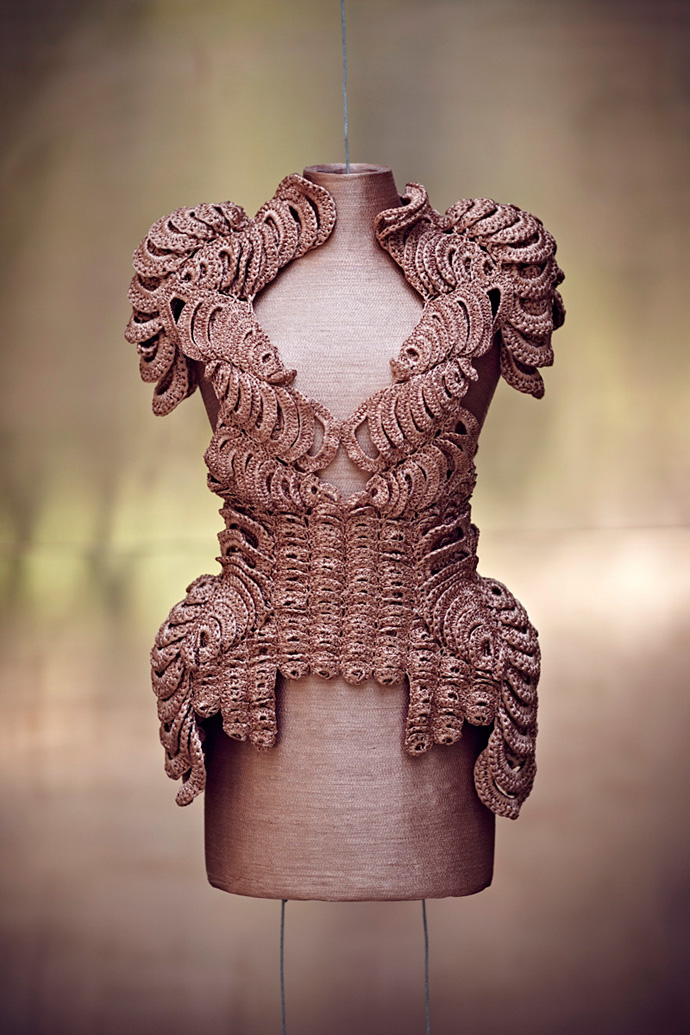 Sandra Backlund's installation CUPRUM 2010 at the Villa Noailles' pigeonnier. Photography by René Habermacher
Sandra Backlund's installation CUPRUM 2010 at the Villa Noailles' pigeonnier. Photography by René HabermacherRENÉ HABERMACHER: What was the point of departure for this installation and the inspiration behind it?
SANDRA BACKLUND: Everything took off from the position they gave me for my exhibition, the Pigeon House in the north garden of Villa Noailles. I think it’s a very beautiful space, so I wanted to use it as a frame, rather then just a location. Because the house is partly open and the exhibition would run for one month outside, I had to carefully consider what material to work with. Already for my current S/S 2011 collection I had been working with a metal yarn made from 100% copper, so in a way it came natural to me to continue exploring that material. With a history of use that is at least 10 000 years old, copper is an important part of both our history and the future. It’s one of the world’s most useful natural resources, 100% recyclable without any loss of quality and it’s estimated that 80% of the copper ever mined, is still in use today. In a way I feel like the story of copper as a material and the way I try to approach fashion go very well together.Can you explain me the process of planning, and the making of the dress?
As always, the handicraft techniques and the human body is the main starting point for me. I never sketch, instead I work with a three dimensional collage method where I develop some basic bricks that I multiply and attach to each other in different ways to discover the silhouette. The only thing I decided already from the beginning was that I wanted some kind of link between the signature piece (the paper origami top) of my winning collection from the 22nd edition of the festival in 2007. Because of the different techniques, materials and colours and because of the process, I guess in the end the link is not so obvious, but there is a few things that is still noticeable, like the silhouette and the size gradings for example.I’ve witnessed you working day and night on this piece – do you have a clue how many hours went into the making?
To be honest, I think that this is the longest piece I have ever worked on. First of all, crochet is always extremely time consuming, especially when it’s layered like this. The copper tape is also very fragile and ones it’s used it, it’s impossible to change, so I had let go of the control and in a way let faith guide me to the end result. If we are talking hours, my estimation is around 500-600 hours.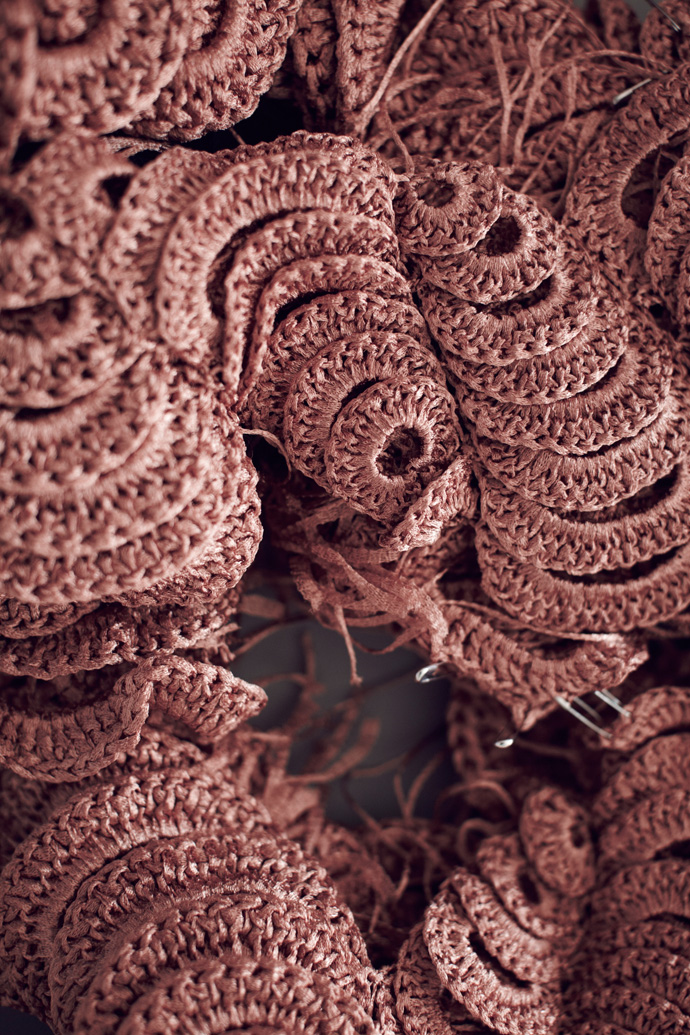
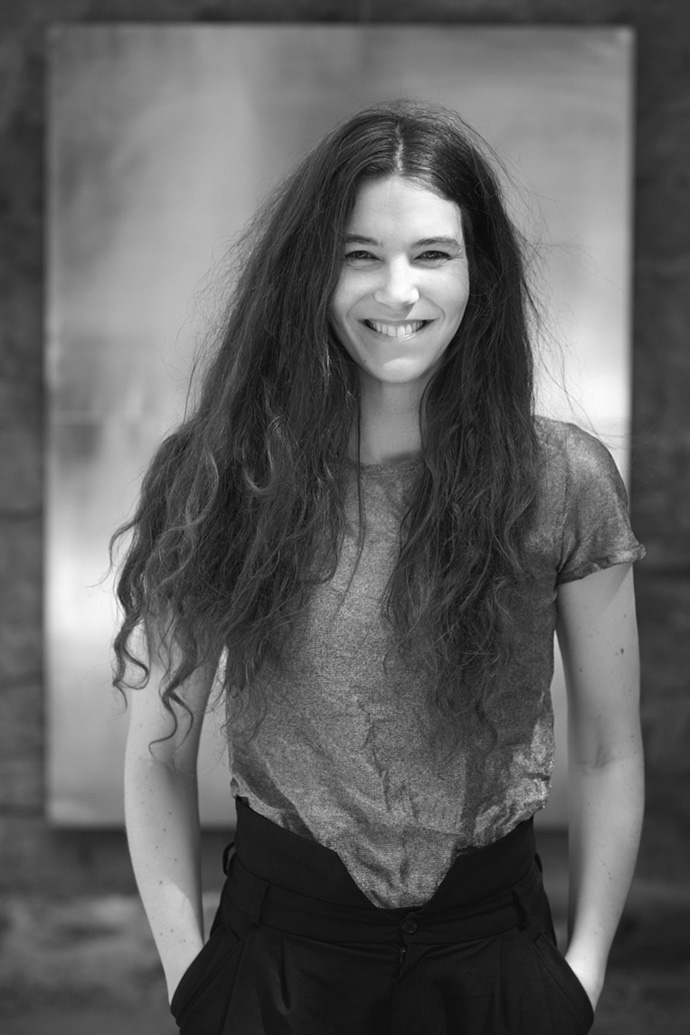 Pieces of copper yarn in the the making, and Sandra at the exhibition space. Photography by René Habermacher
Pieces of copper yarn in the the making, and Sandra at the exhibition space. Photography by René HabermacherYour pieces are often very sculptural, with the artisan work involved, i wonder wether you consider to put your work in a different context than fashion?
Of course I have consider this and many times questioned if fashion is really the right context for my work. As you said, my clothes are always quite sculptural and I also use methods when working that is more close to a sculptor’s, then a tailor’s. But somehow I always come back to the human body. I like to consciously dress and undress different parts of the body and I am very fascinated by all the ways highlight, distort and transform the natural silhouette with clothes and accessories. For me fashion is also one of the most democratic art forms, something that we are all related to. You don’t have to be a designer or a stylist to use clothes as a creative statement, but people in general could of course be more self-governed when t comes to fashion.To me it seems difficult to render your unique approach into industrial production. How are your experiences with that?
About two years ago I was introduced to the long tradition of Italian top knitwear and apparel production. The challenge was to add to my collections something inspired by my hand made pieces that could require only a limited amount of manual work. It was of course a big step for me to go from working alone in my studio, inventing pieces while doing them myself by hand, to suddenly be working in a team of experts within a field of fashion that I never before have had the chance to get to know. I was overwhelmed by all the possibilities I saw and even though I will never give up doing my hand knitted signature pieces, these production tests really made me understand that there is ways to develop my collections that I never thought was possible.What is this festival of Hyères to you? How was it to win – and to be back for this project?
The whole event is really an experience for life when you’re a young designer, all the people you meet and the rush from showing your work in a context like that. I didn’t know about the festival before I met Diane Pernet and she suggested that I should apply. I was crazy happy already when I was selected for the finale and then the wind up… It’s really an important moment in my career so far and to be back again this year and meet everyone was kind of a flash back. When I think about it, I’m still a bit shocked that I was the winner.What’s up next?
F/W 2011-2012 production, S/S 2012 collection and some up coming exhibitions.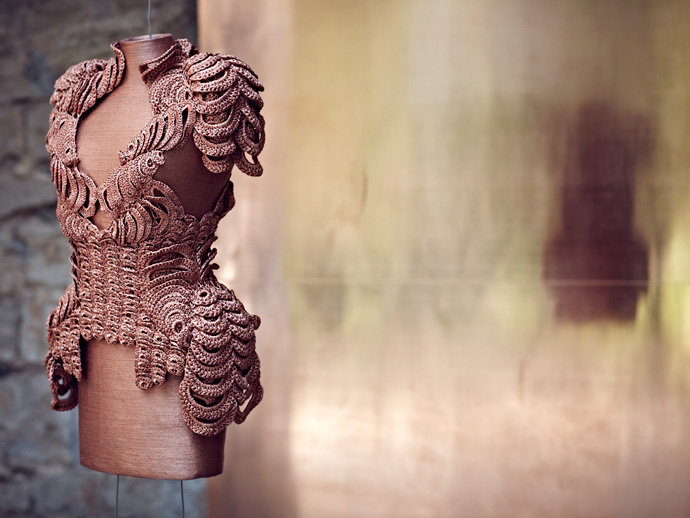
The dress weights over 6kg, made from an archaic material that was the first to be 100% recyclableFurther information on Sandra Backlund: sandrabacklund.com
The Exhibition at the Villa Noailles in Hyeres runs throughout May until the 29th -

Hyères Alive ! Fashion Shows & Awards Ceremony
-Semi-live from Hyères, it’s Hyères Alive !
Hyères 2011 Fashion Shows.
Hyères 2011 Award Ceremony.
Directed by Antoine Asseraf
Filmed by Antoine Asseraf + Jason Last
Edited and post-produced by Clément Roncier
Voice and coordination by Lynsey Peisinger
Sound Design by Lori Schonberg -

HYERES ARE THE DESIGNERS
-Below our office window in the mythical Villa Noailles, people sprawl in the gardens, visit exhibits and discover new designers and photographers. Creative stimulation everywhere. The yearly invasion of Hyères, a sleepy town in the Côte d’Azur, is at its peak, with this micro-festival gaining even more attention by the international press.
On the secluded terrasse in front of us, Raf Simons, the President of this year’s jury, sits in the shade of an umbrella having conversations with numerous journalists, while simultaneously the crowds gather and mingle: headhunters, designers, buyers…
Christopher Kane is here, teamed up with Carla Sozzani of Vogue Italia, Jack and Lazaro of Proenza Schouler came in from NY to have a look at the 10 designers’ work.Its Hyères-storic.
All Photographs by René Habermacher
ODA PAUSMA
Netherlands“It’s very much about contrast: My work is always focused around the vulnerability of women. I play with it, I try to hide it or extend, to show it or protect it. This collection is really about my most vulnerable moment because I ended love after nine years of relationship. I thought I should speak about this in my own language which is fashion. In the beginning it was all black. But later on in the process I was getting better and was seeing the good things about my situation:
Life goes on and there is so much in the world, so I said to myself don’t worry so much! The world is sad enough, so bring some light!
So I brought that into the collection by using white and Swarovski elements and my favorite materials silks and leathers, to work the contrast between fluidity and the protective. The silhouette is very tall from the waist on, so it looks a little surreal and dramatic.”
“The last thing that stimulated me was just my surroundings I guess. I am having a lot of fun lately and I am really enjoying this festival: it gives me energy and I want to move on and work and do something with this feeling of being selected and being a little proud to be so. It’s a good feeling, so why not do something with it.”
JULIETTE ALLEAUME & MARIE VIAL
France“We always help each other on our own collections, but this is our first official collaboration.
We met in high school while studying for our baccalaureate in applied arts. After that we pursued fashion design in different schools–I was at Duperre and Juliette was at Chardon Savard. We lived one year apart and then moved in together in order work together. In fact, the collection that we are presenting in Hyères, is a collection that we made during the time that we shared an apartment.
As for the collection…our starting point was a scarecrow. Using the image of the scarecrow we started to explore the feminine silhouette. Eventually we turned this silhouette upside-down and reworked all of the different facets of it. We were also inspired by cubism so, in the collection, there is the idea of a double body–like one body superimposed on another. For example the shoulders have large proportions and are backwards, the skirts are divided in two and are skewed –so all of the body parts are somehow decontextualized. And we see the real body underneath or in the back, usually highlighted with bright colors. All of this creates disproportional, unhinged silhouettes. Plus, the wooden shoes for the collection create a strange walk”.
“The last thing that stimulated us — Well…the festival! And getting the chance to show our first collaboration. Since we were at different schools, we never had the chance to realize a project together and it is the energy of our duo that motivated us”.
www.artifactcollection.tumblr.com
MADS DINESEN
Denmark“I try to make a spirit army with no nations and no faces. My collection is a lot about shame and pride and the feeling of guilt.
It’s also about how to use the past in the present and the future and learn from it. This is my graduation collection. At the university in Berlin we do one each semester but this is the biggest one and the first with so many pieces. Though it’s a men’s collection, I showed it on women as well in the past.”
“The last thing that stimulated me was the film HOLY MOUNTAIN. That’s one of my favorite films. But right now I am looking a lot at Easter bunnies because I saw DONNIE DARKO. I use a lot of film and music in my work and literature.
Holy Mountain was part of the inspiration for this collection but mostly the colonial history of my home country Denmark. Because when I moved to Germany I found out I didn’t know anything about it, so the research for the collection started in Iceland. I went for a residency to Reykjavik and collected pieces of each culture that was under Denmark. It’s more like a typology of cultural pieces that I tried to put together.”
LEA PECKRE
France“The collection that I am presenting is the collection that I presented for my graduation at Lacambre last year. It’s called CEMETERIES ARE FIELDS OF FLOWERS. I am using a lot elements from cemeteries that interest me like wood, tombstones, mausoleums, bouquets of flowers, the contrast between wrought iron structures and the landscape. These elements, reworked in the materials used for the collection, provided me with really organic shapes–somewhat like trees that climb stones in the cemetery for example. There is a lot of embroidery in the collection as well.
Here in Hyères the defilés are much more structured then at Lacambre. But actually, my show at Lacambre was one of the more simple, subdued shows, so the Hyères show fits really well for me. I like when it is rather simple.”
“The last thing that stimulated me last: I want to finish my collection for Hyères! I am developing new pieces reworking some of the existing pieces and I think it will add a lot to the collection and that it will be better.”
-

I COULD BE YOURS ! jean-paul lespagnard
-In a joint interview with Caroline Daily, we talk with Yelle collaborator and 2008 Hyères winner Jean-Paul Lespagnard about his first Paris Fashion Week presentation…
I Could Be Yours - Fall/Winter 2011/12 presentation, filmed by Antoine Asseraf & René Habermacher.
Antoine Asseraf: Did your presentation go well this week?
Jean-Paul Lespagnard: It went really well. The feedback is really good. It was very difficult to organize, obviously, but as I always say “we learn from our mistakes”. ha ha. In the beginning I wanted to do something simple and small and in the end, I found myself doing 7 shows in one day! My assistants tell me all the time that when I tell them something, I think that it is really simple, when in fact it isn’t. So when I tell them that we are going to do something difficult, but that we will succeed, they know that it is going to be a mountain of work! But really really happy with how everything went. The people from the press are really enthusiastic. The people that came by the showroom are very enthusiastic too. I had some buyers–one from a boutique in NY, one from a boutique in Hong Kong, among others.
Was it complicated to plan?
It was a personal choice to put myself in the “off” on presentations by appointment. And i think that I will continue to do that. Because, this idea of doing 6 shows in one day was difficult and I launched myself into a crazy adventure, but I really want to do it again. I think its great because people can come whenever they want to. There is something that I like about not having chairs, it was standing only. I think that the next time, what I could do is have little portable stools for people that want to sit down. I just really like the idea of something spontaneous like what we did. So something that I am going to work on and try to perfect for next time. This defilé was meant as a way for me to come back after the festival and to present my work to buyers. When the buyers came to my showroom, they said “its great, its fresh, we have never seen this before, but we are not sure where to place your work for the moment” This is good actually because now, they have 6 months to digest what they say and to think about ideas for where to place my collection and about where my stuff fits in with other designers. I really very very happy with my fashion week in Paris!
(more…) -

-

25 Hyères + POP
-Less than one week before the launch of the 26th edition of the Hyères International Fashion & Photography Festival, The Stimuleye brings you “25 Hyères” covering the 2010 edition – including interviews of Dries Van Noten, Walter Pfeiffer, Olivier Lalanne, Théo Mercier and many others.
“25 Hyères” premiered on POP, where you can also read an exclusive interview.
THE STIMULEYE presents
25 Hyères
2010 Hyères International Fashion + Photography FestivalVideo and interview on THE POP.COM
A film by Antoine Asseraf
Music by
Lori SchonbergVoice-over by
Géraldine Frainais
James DeenyFilmed by
Antoine Asseraf
Jason Last
Yoann LemoineEdited by
Antoine Asseraf
NEUE / Axelle Zecevic
Yoann LemoineInterviews by
Antoine Asseraf
Jason Last
Diane Pernet -

everything you need to know about hyères in 2’6″
-One of our favorite events here at The Stimuleye is the Hyères Fashion & Photography Festival, held yearly at the Villa Noailles. Since 2007, each year the festival asks me to make a teaser to give a glimpse of the upcoming festivities.
There are always so many things happening simultaneously at the festival, that it’s hard to follow it all. This year shouldn’t be any different, with the addition of a new, long-in-the-making permanent exhibit about Charles and Marie-Laure de Noailles, the Villa’s inhabitants and art patrons.
So, because I thought it would be good to start at the beginning, go through the middle, and stop at the end, here’s everything you need to know about Hyères in 2 minutes 6 seconds to be ready for the 26th edition.
The Stimuleye crew will be going to Hyères…more to come soon. See you there ?
Hyères Fashion & Photography Festival,
April 29 – May 2, 2011
Villa Noailles, Hyères
Exhibits until May 29th. -

NEW EYE : Marc Turlan
-The Stimuleye is proud to announce its new eye, created by artist Marc Turlan.
Preview of 25 HYÈRES film, directed by Antoine Asseraf.
I had the pleasure of meeting Marc Turlan in his atelier in 2007 when making the first teaser for the Hyères fashion and photography festival.
For what was to be his first solo exhibition, MANQUE (“lack”), Marc had prepared a series of sculptures based on magazines partially hidden under resin-masks. The result was very Friday the 13th.Then in 2008, Marc made a limited series of sculpted magazines, TORN MAG.
He carved magazines, as objects, blindly, until their substance was exposed. Since then, his work has evolved to ink drawing, laser cutting, metal beading… on magazines.Full view of the TORN MAG piece. 2008, courtesy of Gallerie Anne de Villepoix.
Last year, Marc returned to Hyères with a new exhibit inside a custom-made wooden bunker, SUMMER HOUSE, which is featured in the upcoming film “25 Hyères”.
Marc is now planning a book for May with Rue 89, and his first solo show at Anne de Villepoix in September 2011…
-

-

25 Hyères preview : Walter Pfeiffer
-The 26th edition of the Hyères International Fashion & Photography Festival is fast approaching, and soon our film on the 25th edition will be out. Here’s a quick preview, featuring a visit of Walter Pfeiffer’s exhibition by Michel Mallard…
Excerpt of upcoming film "25 Hyères". by Antoine Asseraf
Dries Van Noten, Steven Klein, Oliviero Toscani, Theo Mercier and much more in the full documentary.
26th Hyères Fashion & Photography Festival, April 29th – May 2nd 2011.
